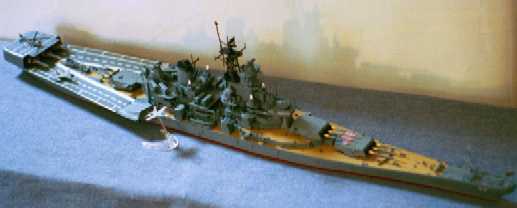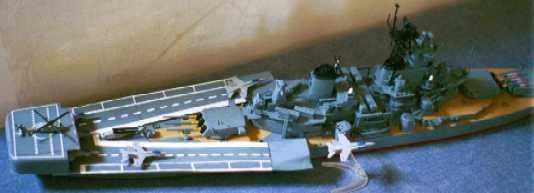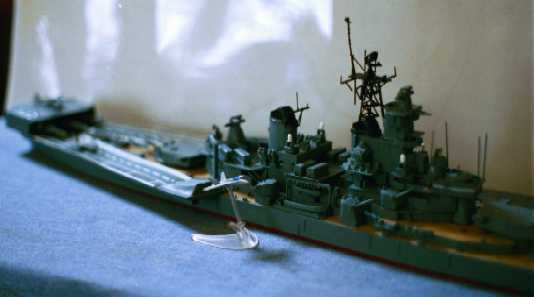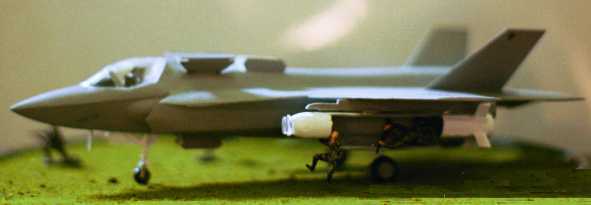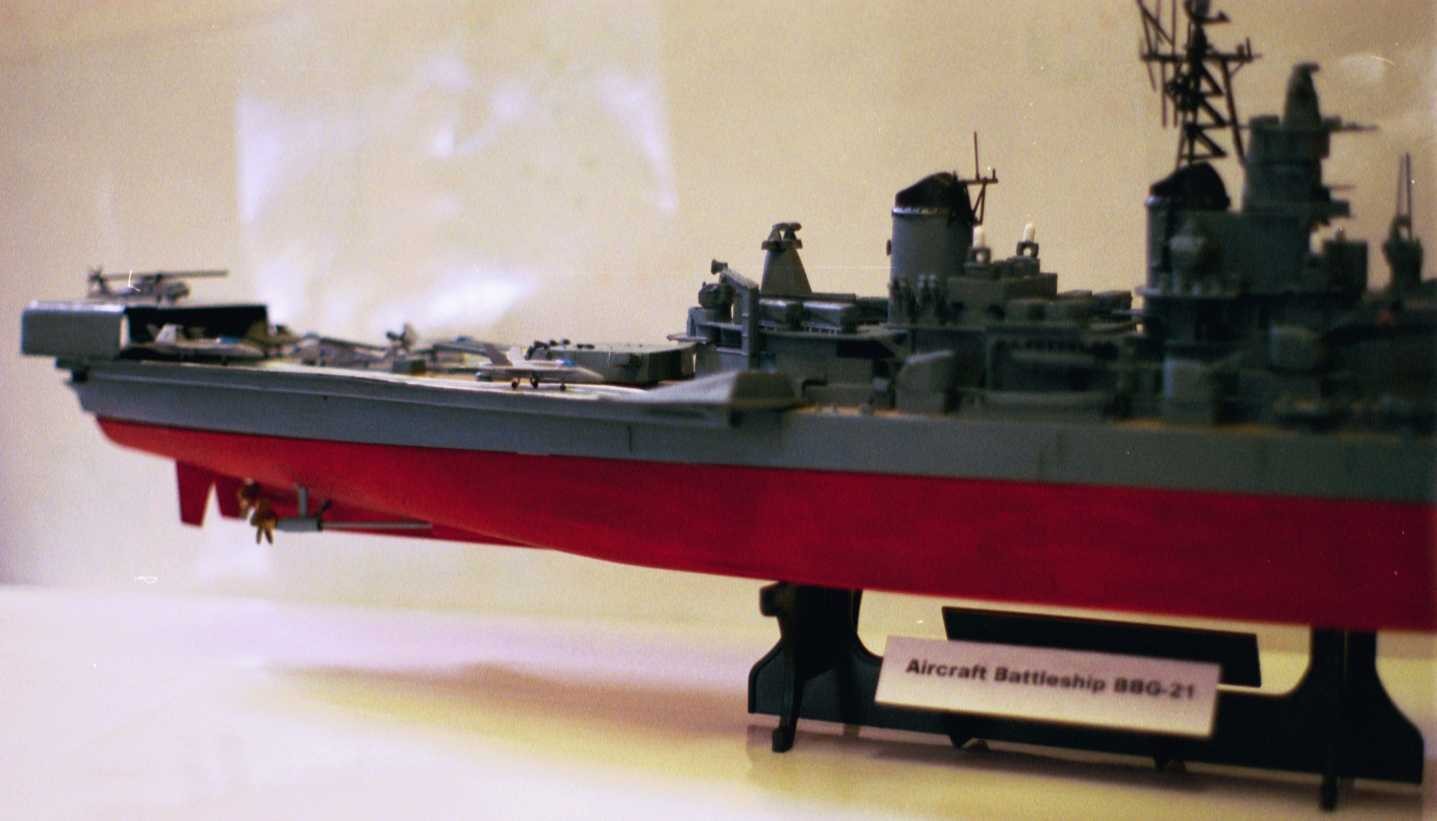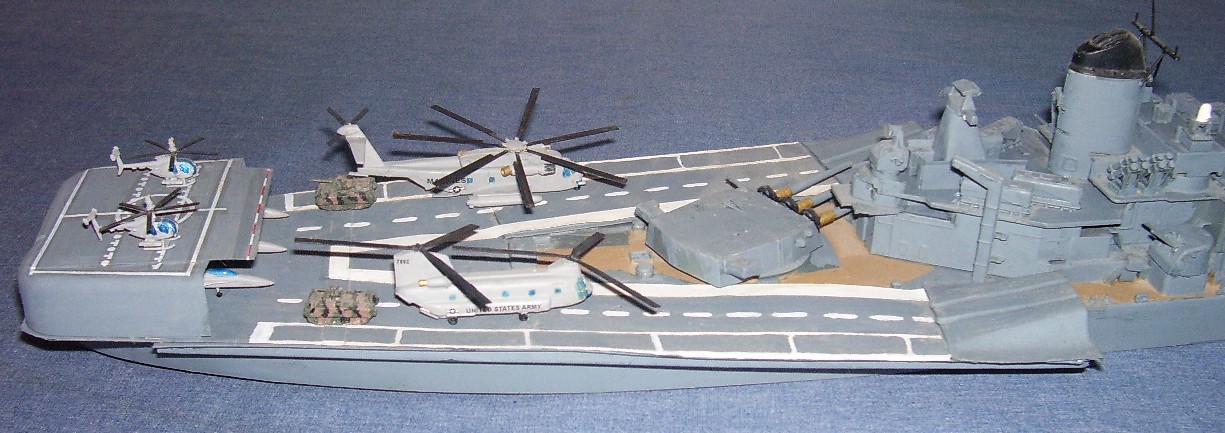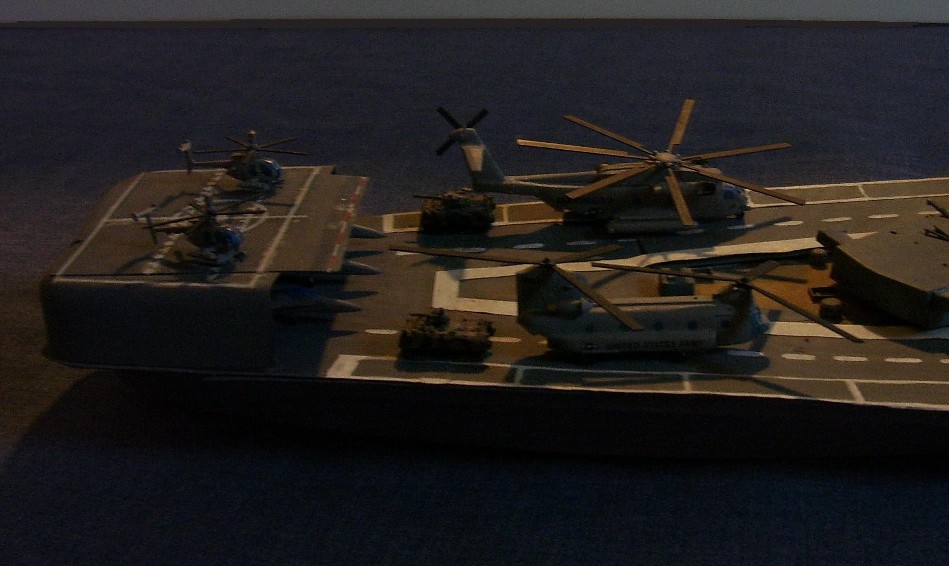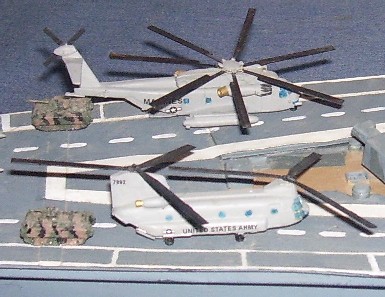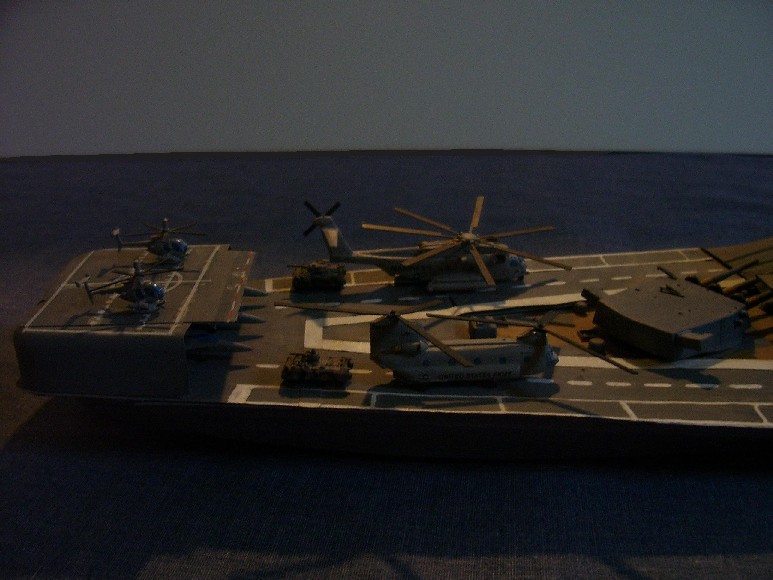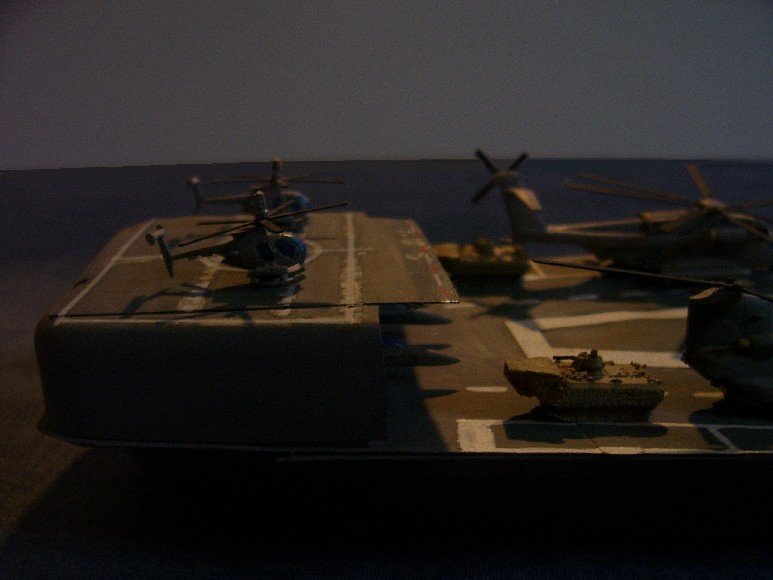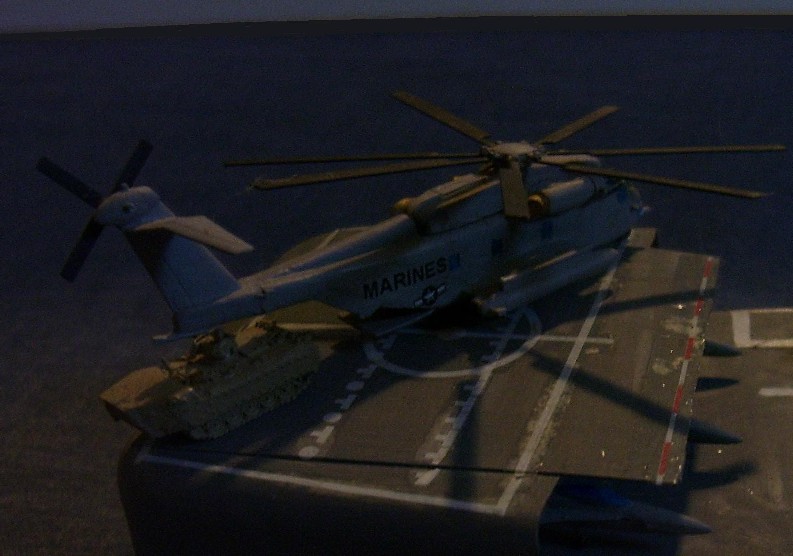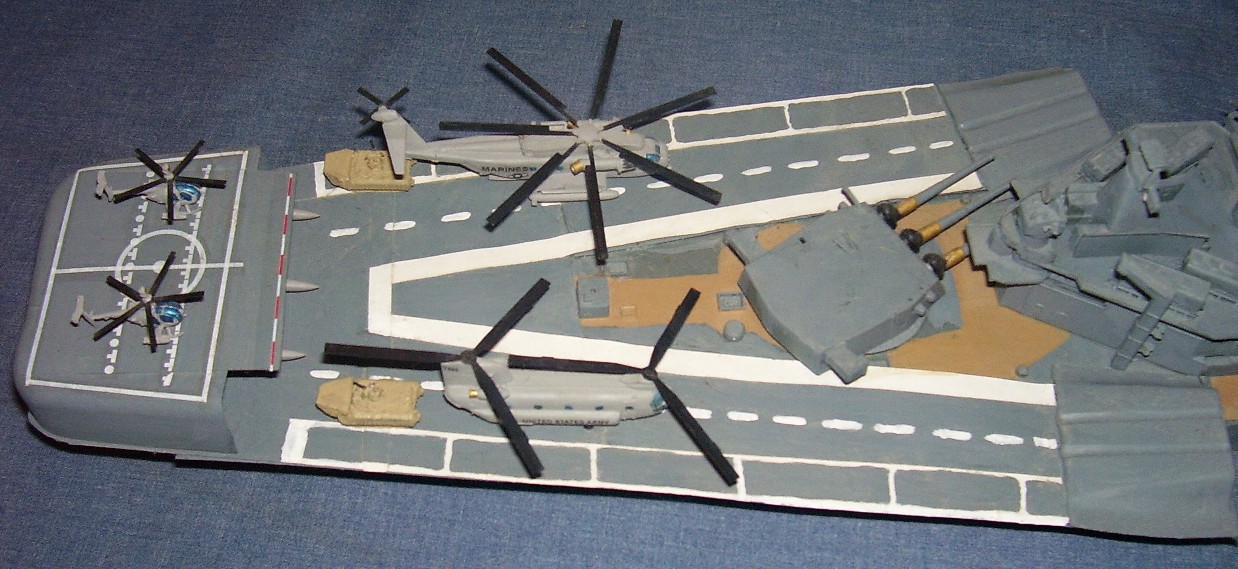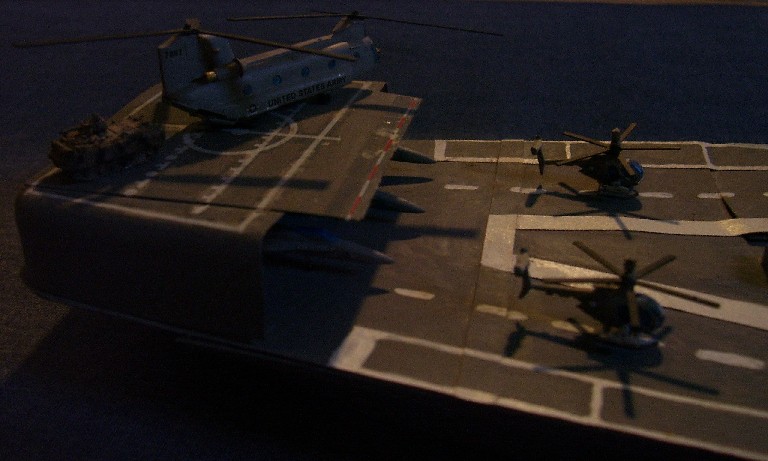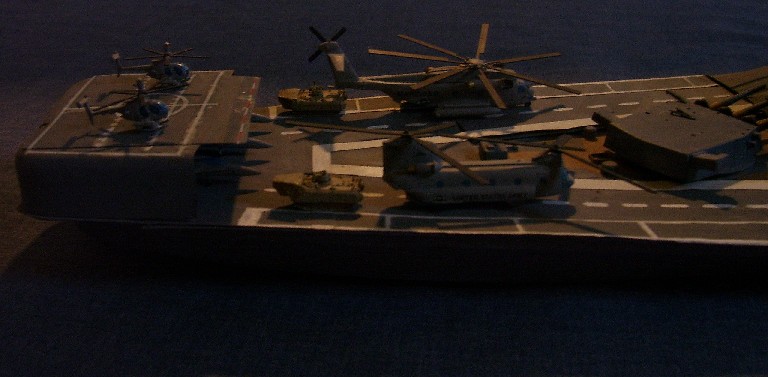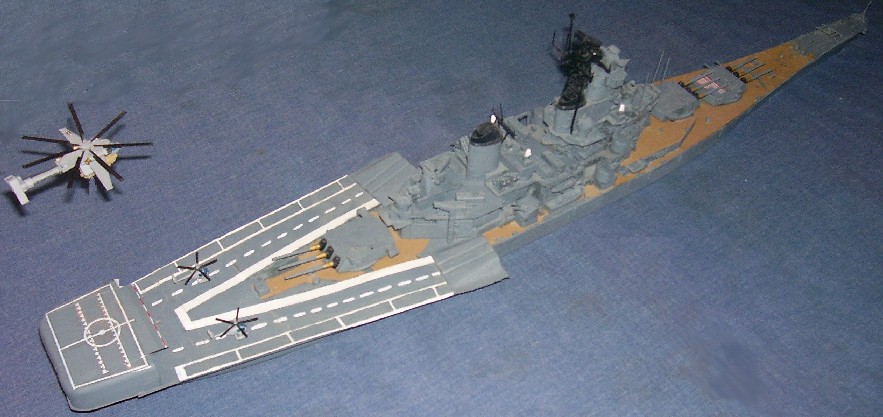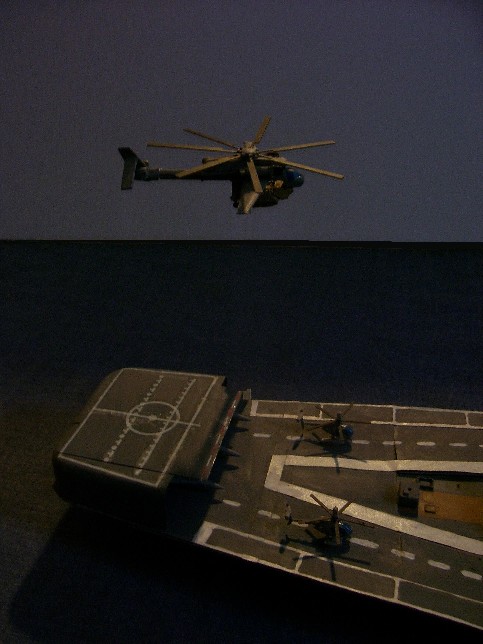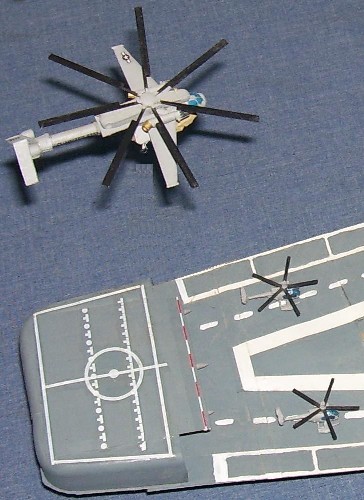Battleship Interdiction of Rogue Nation-States and Sub-National Terrorists: hard armored mobility and deep, precision strike at sea needed
By the Naval Fire Support Battleship Working Group of the 1st Tactical Studies Group (Airborne)
 U.S. Army Colonel Shawn Welch's "Solving the Naval Fire Support Gap" White Paper
U.S. Army Colonel Shawn Welch's "Solving the Naval Fire Support Gap" White Paper
PART 1: The Prelude
On November 12, 2009 the unthinkable happened.
A third world country launched a nuclear-tipped missile at its neighbor; Pakistan's supposedly "moderate" Islamic ruling council without warning, struck at Indian troop concentrations to stop what was thought to be an impending invasion. India then retaliated with its own nuclear weapons, killing millions of Muslims and creating a call to arms throughout the world to exterminate India.
The U.S. rushed an aircraft carrier battle group to the scene. However, thousands of miles away, Communist China began massing troops adjacent to the straits of Taiwan after that country declared their independence. Another CBG was sent towards Taiwan but with strict orders not to enter the confined waters of the straits. Satellite imagery flashed into the targeting screens of the Chinese Strategic Missile force headquarters and buttons were pushed. Back at Washington D.C. phones rang of the reported ballistic missiles being launched. "Would China start nuclear war over Taiwan? All we did was move a carrier group towards it. The radar screens answered our questions. The Chinese missile arcs were coming down far closer than the continental U.S. (CONUS). Everyone drew a sigh of relief. A computer screen operator burst our euphoria bubble; "Sir the Chinese missiles are coming down on our aircraft carriers." The senior watch commander said to alert them. "Its too late sir, they have already struck, there were too many for our missiles to stop them. The Nimitz vanished from our screens 3 minutes ago, the Carl Vinson is on fire and abandoning ship."
The President called in on the red phone asking for details of the national tragedy. The senior naval commander picked up the phone. "No, Sir. We cannot get any more carriers there. No, Sir we cannot go through the Panama Canal with a carrier. The Army and Air Force will have to go to bat for us. Yes, Sir, thank-you, Sir".
Then the light came on.
The war game simulation was over. Participants at the Naval War College were stunned. It had happened so fast as they were fixated on their hunt for terror leaders in Afghanistan, they didn't see it coming, either the Pakistani nuclear strike or that the Red Chinese had aircraft carrier-killing ballistic missiles. "Where did they get such accuracy?"
As Admiral Jeremiah Simpson walked away he remarked to marine General Scott; "From us of course. Not only are they putting men in space to do ocean surveillance, they buy imagery from anyone who has satellites and in need of some quick cash. Jeff, we have 4 countries right now developing weapons of mass destruction deep underground and we can't get at them, the Indians are putting their missiles into hardened silos for a 'second-strike' capability even if Pakistan should launch a surprise attack". Scott was stunned. "We can't get them with air strikes?". Simpson shook his head. "We cannot get them for sure. The planet earth is still a very big place to hide things in. Its the Cuban missile crisis all over again, except this time its not Cuba with the missiles its Pakistan, India, Iran, North Korea, the genies are out and we can't get them...if we send in swarms of attack planes with men and they get shot down, we have a hostage crisis...or worse public trials like Gary Powers and the U2....". Scott scratched his head. "What about those cruise missiles you guys shoot off at a million dollars a pop?". Simpson stopped and faced Scott squarely. "We cannot shoot enough of them at one time to get them all. The Tomahawk only carries a tiny warhead and can't go deep. The only sure answer is to send in ground troops."
Scott was really alert now.
"But we learned when former Secretary of Defense MacNamara visited Cuba that Soviet submarines had nuclear torpedoes ready to wipe out our Navy invasion fleet with all our marines in '62. Its too risky to mass vulnerable surface ships packed with marines against even third world navies with diesel-electric submarines and CNN to alert them we are on the way". Simpson agreed and added; "Think about North Korea. We know where those hard targets are, but we don't have a way to take them out without getting ground troops in there which we can't do without setting off a bloody war on their home turf in the mountains...and then it would be too late because they could launch against the West coast. Did you know a North Korean ballistic missile landed awhile back in Alaska?" Scott was dumbfounded. Simpson continued. "Digging in nuke missiles isn't the only way to avoid our targeting; there is C3D2. Ever hear of that? Scott shook his head. Camouflage, Cover, Concealment Deception and Deceit. The North Koreans are real good at letting us think we know where there stuff is and most of it is just plywood decoys. We know where they are, but we can't effectively hit the ones that are real. We need to hit everything, but we'll go broke using million dollar missiles even if we had enough of them. What do we do?" [1]
A scientist from across the room heard the general officers conversation.
"Gentlemen, I think I have your answer...I'm Doctor Gerald Mitscher".
A short man with a stocky build born of his days as a former Army infantry officer but now a defense theorist, Mitscher knew what he was talking about.
"The most efficient way to project ordnance is the gun. An armored platform with its own modest air cover could venture into a third world country's littoral waters even if diesel-electric submarines and terrorists in boats are lurking. Once in position, the mere threat could force the rogues to the bargaining table or lull them into complacency before we strike and catch them off guard. Right now we have 25 mile range and an ability to penetrate 60 feet of concrete with our 16 inch guns. If we developed scramjet rounds that fired from Iowa-class battleship 16" guns we could simultaneously strike targets as far as 500 miles inland and hit hard and deep enough to get enemy hard targets that are development facilities or actual launchers of WMD's without risking an American pilot's or Soldier's life if we are in that twilight between war and peace where we could surgically eliminate a rogue's WMDs without causing full-scale war. If we have to go to war to topple a rogue nation-state we darn well better be sure we get their WMDs before we land troops as the Cuban thing teaches us. We have identified most rogue nation-state WMD facilities, the question is how to hit them effectively. Mentally knowing is not enough, we have to be able to PHYSICALLY take them out, and I dare say low-yield nuclear weapons that penetrate; resorting to nuclear war to prevent nuclear war is madness and disaster for world opinion of the U.S. What I suggest is we go back and re-run your wargame simulation except this time you have an Iowa class battleship with 1500 regular and scramjet rounds, a 'BBG' on station in the Indian ocean when the rogue nuclear nation considers nuking their neighbor. See what happens."
Simpson was cynical. "This is another technofantasy".
Mitscher was adamant; "No, sir the South Africans already had land-based 155mm scramjet rounds ready. For sale to whoever has the cash". [2]
The wargame simulation was replayed and this time no nuclear exchange took place because both sides knew that they could lose their nuclear edge in a few seconds if the U.S. chose to destroy their nuclear arsenals and take away their "nuclear status"..
PART 2 : Making the BBG-21 a reality: it takes a battleship
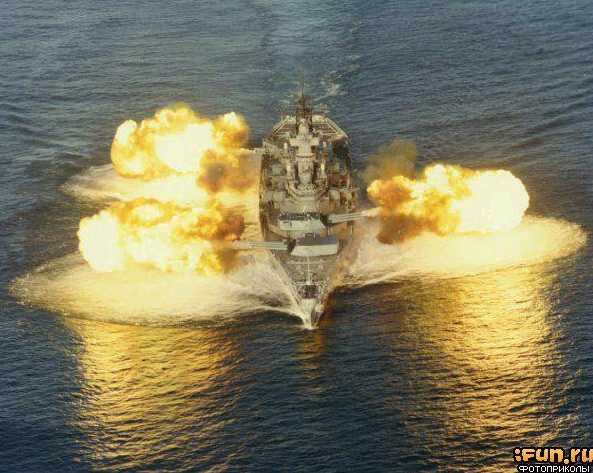
The following techno-thriller is more fact than fiction. America today lacks the "gunboats" to effect a diplomacy of deterrence and failing that seriously intimidate a rogue nation-state with WMDs because her Navy has gone soft. With vulnerable aircraft carriers and surface ships armed with just missiles or aircraft, its problematical if deeply fortified and buried targets will even be hit much less destroyed since to get into launch positions, Navy ships would have to withstand multiple bomb, missiles, seamine, torpedo hits. [3] By flying ordnance via aerodynamic means farther and farther away from land in order to protect soft surface ships from enemy coastal defenses, this ordnance also has become physically weak by increasing amounts of electronics gadgetry displacing physical explosives. The defacto result of our soft Navy has been we have to attack pre-emptively rogue nation-states with possible WMDs with ground maneuver troops through invasions, and if you cannot first get a good amount of the WMDs through saturated precision strikes, The weapons may get used before you can remove them as a threat. If your troops find no WMDs as what happened in Iraq, you have just broke a nation-state government and become the ugly occupation troops for years afterwards. If the Army and marines are soft from years of easy victories toppling small nation-states like Grenada, Panama and Haiti and find the insurgents are blowing them up in their HMMWV and Stryker wheeled trucks on this non-linear battlefield, preventable casualties will mount. Just as America's Army needs to be fully armored and mobile in tracked armored fighting vehicles like M113 Gavins which can be given multiple layers of armor while retaining unsurpassed x-country and amphibious mobility, so must her Navy to survive on today's increasingly lethal battlefield. Soft armor that absorbs the impact of weaponry and disables the vehicle as seen in the so-called "armored HMMWV" truck and Ticonderoga and Burke class Aegis surface ships is not true armored capability. If the enemy's strike forces you off the field of battle, he has won even if you live to fight another day after you limp home and wait for repairs or another $1 billion dollar soft armored ship packed with electronics is provided. America's populace are not on a war footing; we go to war without what we already have on hand, win lose or draw. If we have soft-armored platforms we could very well lose. What we need is HARD armored platforms; ships that can take enemy hits if our situational panacea is anything less than perfect; and still stay on the battlespace and prevail.
Our Soft Navy Needs Hard Armored Battleships
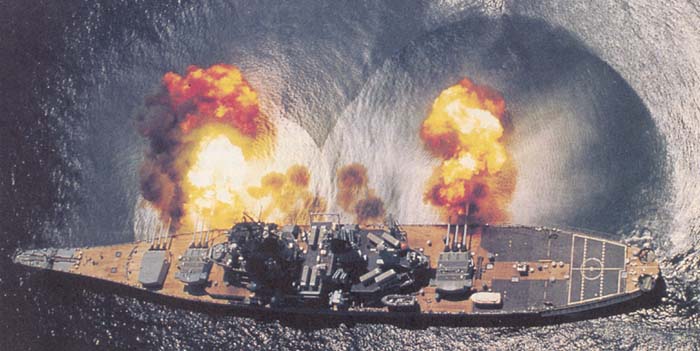
Contrary to popular myths, the U.S. Navy has NEVER lost a battleship once underway (moving).[4] The battleships lost at Pearl Harbor by the Mitchell-esque surprise air attack were stationary at anchor. In fact, after Pearl Harbor the U.S. Navy did not lose any battleships ever again, but she did lose dozens of aircraft carriers. What has been lost here is that the battleship really represents two ideas; long-range powerful guns AND a very armored platform that can take hits and keep fighting. Most people confuse battleships as offering only guns and then conclude they are no longer needed because aircraft carrier planes have longer range, overlooking the necessities of having hard armored mobility at sea. Just look at the horrific losses the Royal Navy suffered during the Falklands War in 1982 where their post-armored age ships literally melted and burned her sailors up.
Battleships are designed to survive 15" and 16" shells, which are literally 1000 to 2000 pound penetrating warheads, and many better ships also have excellent torpedo belts. And when you consider that most modern anti-ship missiles are optimized against lightly and almost completely unprotected vessels, you see that battleships are still very hard to sink, even on a modern battlefield. Modern anti-shipping missiles (ASMs) like the Harpoon and Exocet partially make up for their small warheads by having a delayed fuse, which detonates after the missile penetrates the thin skin of a modern ship. However, with armored battleships, the delayed detonation advantage gained is completely negated, as the missile will be incapable of penetrating the armor in the first place. The physical weaknesses of current ASMs reduce the already limited effectiveness of these missiles, as it can take over 4 Harpoons just to sink a 10, 000 ton destroyer, and even a 4, 000 ton frigate can survive an Exocet. Larger ASMs with 1000 and 2000 pound warheads (ie Tomahawk naval attack version & AS-4), may not be enough to even seriously damage a battleship if they don't hit it in the right spot, and such missiles are far easier to take down than the light sea-skimmers. The traditional battleship weakness against aircraft has been addressed with advances in modern air defense systems, which are far more effective than the old guns of WWII, and those with good torpedo belts can even shrug off many submarine attacks with ease. These, along with the fact that they were designed to serve in the C2 role, combine to make battleships excellent and highly survivable command vessels.
You may say, the Japanese had battleships even more armored than our Iowas and they were sunk in WWII. But again, the reality here is missed; hard armored mobility on a ship delays being sunk, its not an absolute, just like tanks on land are not invincible. Its during this time that hard armored protection buys you that keeps you in the fight that you can defeat your enemy. The problem the Japanese had was that after Midway they lost the cream of their pilots and they no longer had air cover over their battleships to enable them to get into gun range. Some may mock hindsight as being "20-20", but if we have all the facts, why not learn from them? The totality of WWII teaches us that both the battleship and aircraft schools of thought were right at the same time--but for the wrong reasons. Mitchell was right that aircraft beat battleship GUNS for sinking ships at long-range, but his followers in the Navy were wrong to conclude that they could thereafter operate from unarmored and soft-armored surface ships just because they had lots of aircraft to keep them enemy at a stand-off. Every year this stand-off grows and grows as we work around the basic vulnerability of our ships using ever elaborate electronic means. We now have a soft Navy that can't sail into harm's way because we threw out the hard armored ship's mobility "baby" with the gun firepower's "bath water".
Both Halsey and Mitchell were right: it takes both aircraft and battleships
The Japanese understood during WWII what to do, but did not have the pilots and seaplanes: they made two of their battleships able to operate a small compliment of aircraft for self-defense. [5] We are not talking about an aircraft carrier which is basically a floating airfield that cannot fight packed with fuel and explosives that will go up if hit no matter how quasi-armored you make it. The fact that you have packed so many volatile contents together negates any armor protection you attempt; its too much high explosives and aviation fuel together in a large target. To FIGHT, you need as compact as possible armored platform that if hit does not sympathetically detonate. As WWII ended, the battleship U.S. Navy realized this, too. Why catapult launch impotent Kingfisher seaplanes from battleships and cruisers? Why not launch and recover SC-1 SeaHawk floatplane fighters that can air defend over your ship as well as spot for your guns, and land to rescue Americans in peril in the sea. The Japanese had the world's best seaplane fighters in WWII, they just didn't have enough pilots to fly them [6].
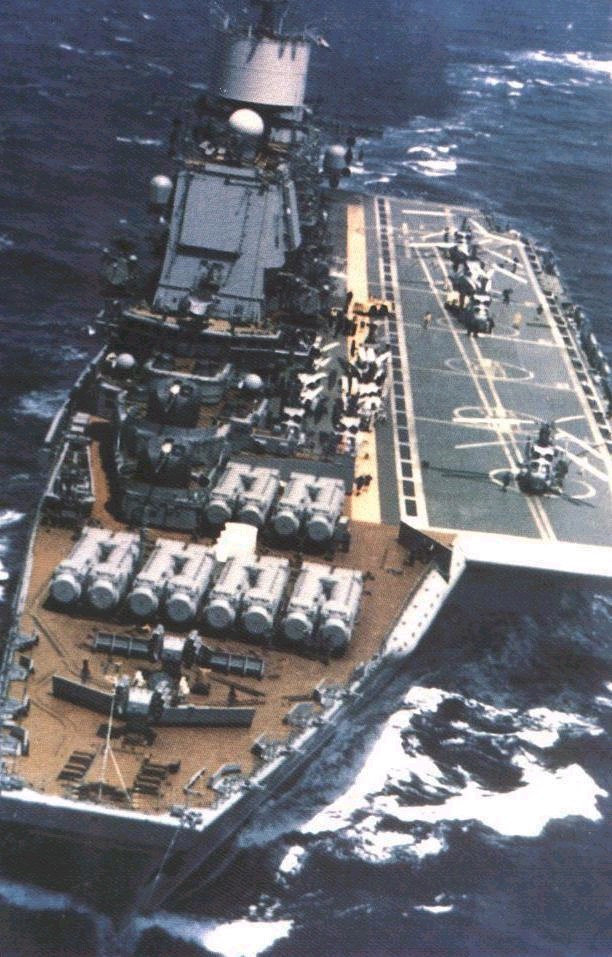
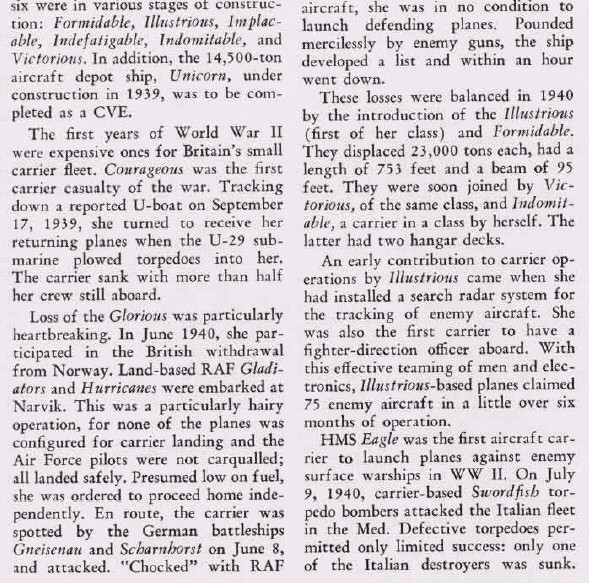
Not having aircraft overhead can also happen paradoxically to full-sized aircraft carriers--- the German battleships and pocket battleships Scharnhorst and Gneisenau surprised and sank the British aircraft carrier HMS Glorious in June 1940. The Russians understand that their surface ships must be able to first fight, aircraft or not. Their Kuznetsov class missile cruiser/aircraft carriers assist aircraft take-off by a bow ski-jump angled at 12°. For recovery, the flight deck has arrestor wires for STOBAR (Short Take-Off But Arrested Recovery) operations. Two starboard lifts carry the aircraft from the hangar to the flight deck. Each ship has the capacity to support sixteen Yakovlev Yak-41M (NATO code name Freestyle), 12 x navalized MIG-29s or Sukhoi Su-27K (NATO codename Flanker) fixed-wing aircraft and a range of helicopters including four Kamov Ka-27-LD (NATO codename Helix), 18 x Kamov Ka-27 PLO, and two Ka-27-Ss. The Russian's missile cruiser/aircraft carrier's up to 34 fighter jets compare favorably to our Nimitz class aircraft carrier's 56 fighters. Without aircraft in the air, our carriers are vulnerable floating airfields that cannot fight, just like the HMS Glorious which suffered an ignominious end. Our armored Iowa battleships can always fight---and they can do it even better with aircraft.
One complaint against our battleships is their alleged lack of "multi-role" capabilities. Did you know that the Iowa is the only combat vessel that has facilities for refueling other ships? Or that Iowas have significant supply storage because they are designed to accommodate nearly 1,000 more men than it currently does? If we practice the "out-of-box" thinking we praise so much, let's consider how we could use that unused space primarily at the rear of the ship, OK?
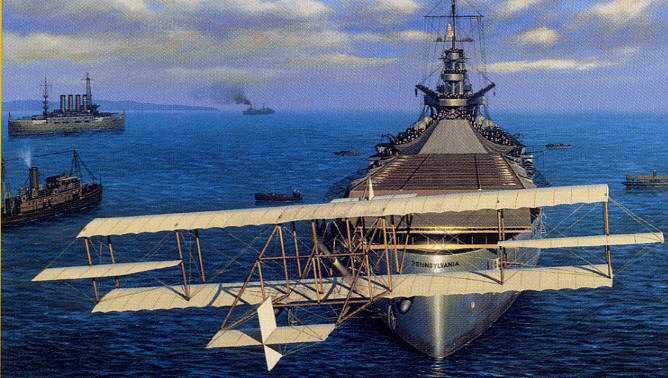
The FIRST naval aircraft/ship interface took place on a BATTLESHIP. Don't let the aircraft carrier liars in the Navy/Mc fool you. WE DO NOT NEED AIRCRAFT CARRIERS TO OPERATE AIRCRAFT AT SEA. Today, we have an unprecedented opportunity with the F-35 Joint Strike Fighter (JSF) whose lift-fan variant can safely short take-off and vertically land (STOVL) unlike the infamous AV-8 Harrier. Not only is the F-35 the world's first practical STOVL jet aircraft, its also radar and infared stealthy to penetrate enemy air and ground radars to destroy its air and ground targets, though what the Iowas need is primarily airborne targeting. The Iowa class BBGs have plenty of rear deck area to operate at least 6 JSFs in addition to the normal 2 LAMPS SeaHawk ASW helicopters to self-protect the ship from enemy fighters and submarines to get into and stay in gun ranges. I propose two small short runway flight decks with ski jumps be added offset outwardly at an angle emanating from the open rear deck areas of the Iowas to enable short rolling take-offs for the JSFs. At the very rear would be a blast resistant hanger with landing pad on top to house the aircraft safely when the rear 16 inch guns fire. For pictures of a 1/350 scale model BBG-21:
Ski jump view
JSF inserting SF team to find targets for Iowa BBG
CAVEAT:
I couldn't find any 1/350 scale F-35 Joint Strike Fighters (JSFs) to go along with the 1/350 scale Iowa battleship with proposed short ski jumps and rear fantail blast protective hanger/landing pad.
So......
I am using 1/350 scale F-18 Hornets that look as close to a JSF as I could find.
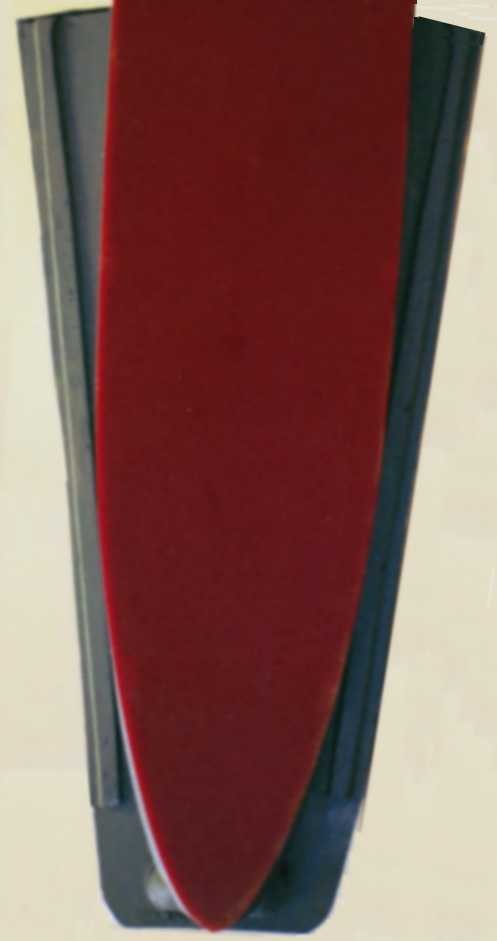
The pic above shows how the majority of the two ski jumps is the already pre-existing, flat rear deck area on the Iowas. If you look at the round rear outline of the Iowa class BBG you will see these two ski jump runways are mostly the rear of the Iowa with only very little new structure overhanging. This concept is feasible and desirable IMHO.
Legendary DoD reformer and weapons designer Chuck Myers agrees and writes:
"The Interdiction Assault Ship:
Not sure where this conversation began but you may be interested to know that when 'making the case' for reactivation of the four Iowas in 1978-79, I designed and we had built what we called the 'Interdiction Assault Ship' which was an Iowa with the rear turret removed. We covered the hole with six inch steel and installed a vertical launch missile farm that projected up into a split ski-jump deck for STOVL operations, helos (today V-22s). All five-inch guns were replaced with 155mm turrets. CONOPS was for the ship to act as a hot deck for various air ops. It had a rear deck elevator and could house about eight Harrier-sized aircraft below in the now hangar bay. It attracted a lot of attention and caused a Navy internal study of Battleship Battlegroups to compliment CV Battlegroups. It helped bring about the acceptance of reactivation but was later discarded (excuse was money). Guess how many CM were in the farm: 320!!!!! Plus six 16" guns and lots of 155s. On a platform which could withstand any ordnance existing in the world. A WAR machine which also served as the command/control ship for the force. The hangar bay could also serve as the temporary home for hundreds of marines or SOF forces..
I envisioned that the skyjump deck and hangar deck would serve as a temporary base for whatever mix of air assets were to be assembled for the particular mission assigned. It could be all "lift/insertion" with the hangar deck serving as a temporary residence for 500 grunts who would be lifted from the flight deck by helo/V-22/whatever. It could serve as a forward fire support base for STOVL fighters or armed helos after the insertion or however desired. It was not meant to become a permanent home for an air group as is the case on a CVN. It had two elevators. The ship would also serve as the command headquaters for the operation; great survivability advantage over todays command ships.
Had a six foot long model constructed which sat in the Pentagon for about ten years where it was viewed by folks who took the 'tour'. Still a good idea."
EXCLUSIVE TO THE 1st TSG (A)! PICS OF CHUCK MYERS'S INTERDICTION ASSAULT SHIP
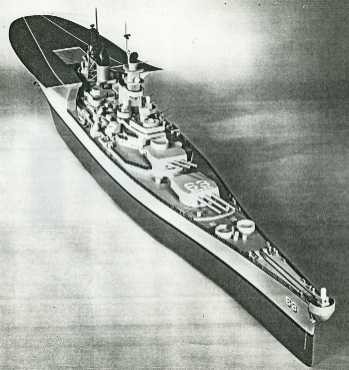
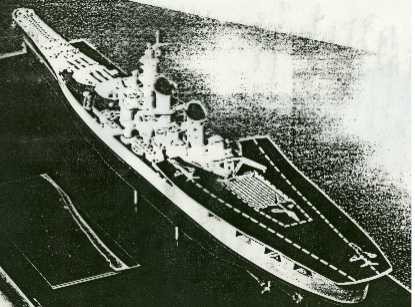
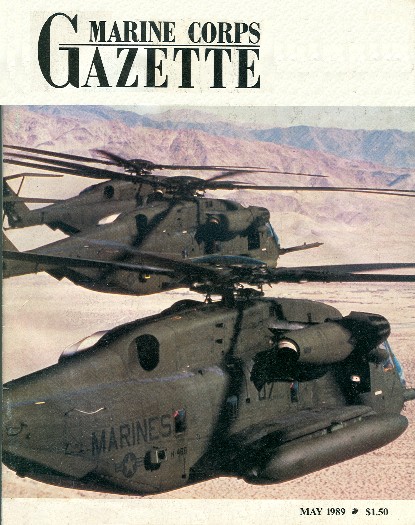
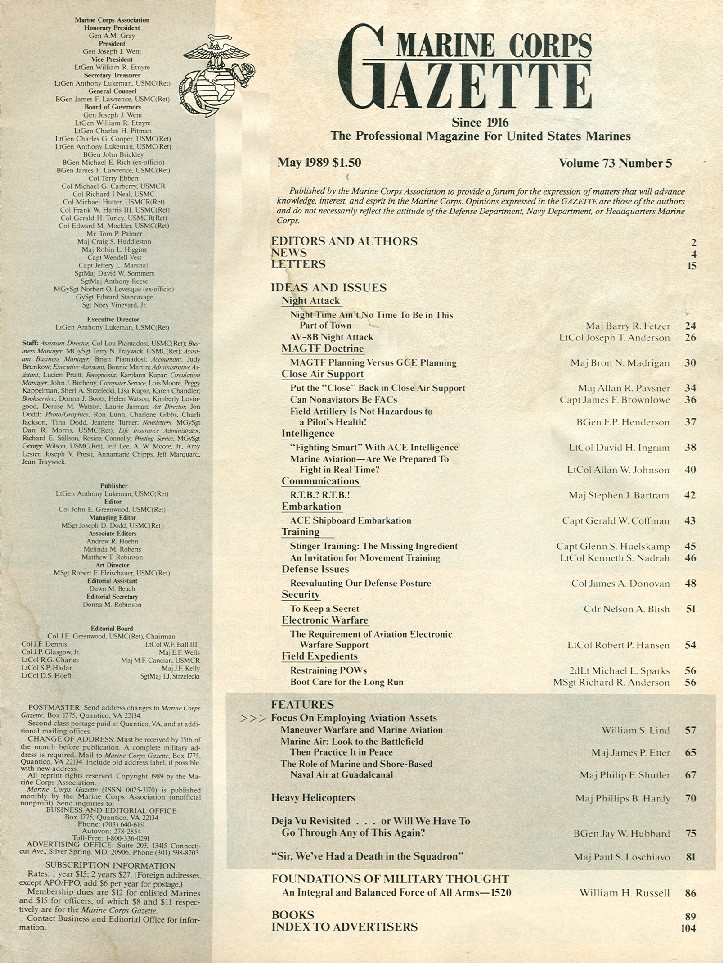
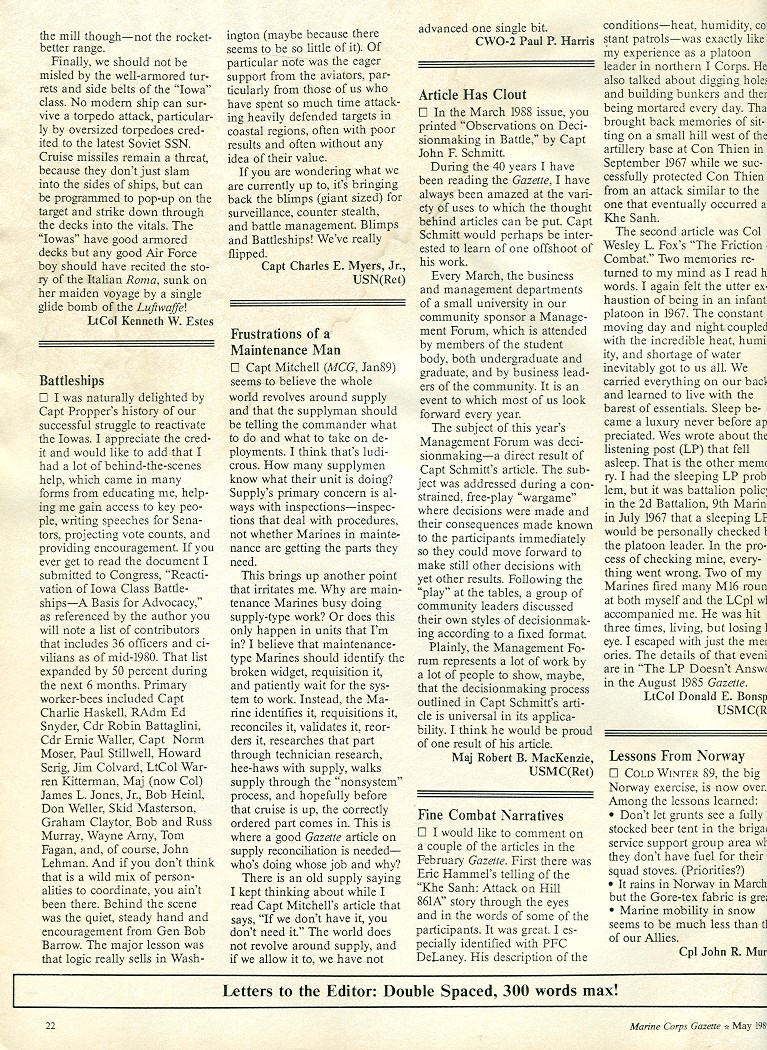
Further investigation reveals that there was a "Phase II" of the Iowa class battleship reactivation that added STOVL aircraft that never took place. By 1979, the Soviet Union's surface-to-surface capability had risen dramatically to alarming proportions. To counter this, the Navy led by Secretary of the Navy John Lehman and Chuck Myers, the DoD director of Air Warfare, proposed reactivating the Iowa Class. Phase I of the reactivation process involved getting the battleships back into service quickly with a minimum of new additions and modifications. This did occur and all four came back to join the fleet. The plan however, envisioned a Phase II. In Phase II, the aft 1/3rd of their main armament was to be removed and a hanger and flight deck added. The hybrids were to carry 12 AV-8B Harrier STOVL "jumpjets". Although less effective than standard carrier aircraft they were chosen because they could be recovered by the ships via vertical landing and thus be reused for multiple sorties. There were a number of different designs for this Phase II conversion, one of which was by Martin Marietta. The Martin Marietta version had an "A" shaped flight deck with two ski jumps on the forward edge. The flight decks would measure 330 feet by 150 feet. A large-scale model of this design was produced and exhibited in the Pentagon. However, by 1984 the conversion momentum for these "Battle Carriers" had evaporated and the Iowas remained gun and missile platforms. The new stealth, supersonic speeds and greater STOVL safety of the F-35 JSF opens up new possibilities for the "Aircraft Battleship".
Another capability of the F-35 JSF is to vertically land and take-off to insert up to 4 men at-a-time using special underwing pods. Boeing makes such pods called "JPODS" and the British company AVPRO has a similar EXINT pod. Thus, the BBG-21's 6 x JSFs could insert/extract up to 24 people per lift. These could be commandos to laser target designate for the BBG-21's guns, do post strike battle damage assessment, snatch VIPs, rescue small numbers of Americans as well as act as spearheads for incoming invasion troops by sea, air or land. To the enemy---if he even can detect the stealthy JSFs, a strike or recon mission is taking place not a special forces insertion or extraction. [7]
When the JSFs are employed as air recon platforms using stealth and speed; the enemy may not be aware that he is being targeted for future BBG-21 gun & missile strikes and unlike Unmanned Air Vehicles (UAVs) which have a tendency to crash/malfunction, the JSFs will have human survival instincts to get them back to the ship. If the JSF is damaged and cannot vertically land on the BBG-21 flight deck it will have emergency skis with pop-out floats to land alongside the ship and be craned aboard so at least some parts of the expensive aircraft can be salvaged if not totally repaired. We cannot afford to be throwing away $1 million + UAVs. Furthermore, UAV imagery is far less revealing than sensors + human eyesight in the aircraft that can investigate suspicious signs to verify targets and not decoys or worse yet civilians are hit. A small, inexpensive air-launched UAV that can fly slower than the JSF would be employed for further investigation if required. If America is to surgically and pre-emptively strike at enemy rogues with WMD facilities/weapons we must not destroy the wrong things and engender world rejection. In a 4th Generation Warfare (4GW) world the legitimacy of our cause cannot be sacrificed for short-term tactical gains. We must be sure of our targets, and to do this we need HUMINT from stealthy scouts in the air and on the ground delivered by F-35 STOVL JSFs operating from the BBG-21. [8]
John Pike of Global Security.org [www.globalsecurity.org/military/systems/ship/corsair.htm] reveals that the need for a small aircraft carrier is generally accepted within DoD:
According to some reports, Defense Secretary Rumsfeld's spring 2001 Quadrennial Defense Review considered recommending that the Navy stop building large-deck Nimitz-class carriers in favor of smaller carriers that could be deployed in the coastal waters. This new class of "pocket" aircraft carriers, designated the Corsair, is envisioned as a vessel of only 6,000 tons displacement, with a crew of as few as 20 Sailors. The Corsair might carry half a dozen of the Vertical Take-Off variant of the Joint Strike Fighter being developed for the marine corps. Alternatvely, the Corsairs might employ Unmanned Combat Air Vehicles [UCAVs]. Vessels like the Corsair might be built for several hundred million dollars, compared with the $4 billion construction cost of a Nimitz carrier. The Corsair could allow the Navy to operate in coastal waters, within range of shore-base anti-shipping cruise missiles, according to proponents of the concept. It could also allow the Navy to provide air cover for smaller post-Cold War operations, such as the peacekeeping missions in Haiti or East Timor, that either divert a Nimitz-class carrier or are conducted without air support.
The CVX design effort in the late 1990s considered a variety of alternative mid-sized carrier designs, including derivatives with alternative flight decks, fossil-fuel propulsion, low signature monohulls, and low signature catamaran.
However, I highlighted important parts of the Global Security.org Corsair excerpt: this small aircraft carrier is supposed to operate near coastlines within range of enemy anti-ship missiles and I might add, stealthy, diesel-electric submarines; how would a flimsy aircraft carrier survive such attacks? In contrast, the heavily armored Iowa class battleship with a "half dozen" F-35 STOVLs would not be at risk of such an enemy reverse. During the Kosovo crisis, EUCOM planners were terrified over the prospect of the single diesel-electric submarine the Serbs had of sinking a Nimitz or Wasp class aircraft carrier, killing thousands of Americans and putting the entire campaign at risk of American public disapproval. Even better, there would be no "several hundred million dollar" construction costs, the Iowas are already built. Instead, a fraction of these monies saved would be add mini ski-jump flight decks and pay for the actual operating costs of a decade of several BBG-21s in operational use. Wouldn't a fraction of several hundred million dollars saved be better spent on actual BBG-21 service in peace/war providing our Sailors the absolute BEST, armored platforms possible to accomplish the mission and bring them home safely?
Naval Gunfire Support: what if we must land troops?


Another benefit of the battleship as it can stay on station by virtue of its armored mobility, is that if the gun boat diplomacy fails it can strike targets with precision using its 16 inch guns without risking any pilots and aircraft that could be captured as the Lebanese 1983 A-6 and A-7 air strike resulted in a man killed and LT Goodman captured. An embarrassing media circus ensued with the Reverend Jesse Jackson securing his release but any super power intimidation & respect to bring peace to the region evaporated until the USS New Jersey's 16 inch guns fired at Druze artillery positions. Consider that firing the main guns alone, and using light projectiles, an Iowa-class battleship can deliver 34, 200 pounds of ordnance per minute. That's 513 tons in a half hour, or the same as two full carrier strikes (72 F/A-18 aircraft) that take several times as long to deliver, assuming "the (fighter-) bombers will get through". The 1983 air strike debacle reminds us against an alerted and ready enemy with fully functioning Integrated Air Defense system, short of full-scale nation-state war to take out the air defenses, the ability to surgically strike while hoping in the aftermath to stay at a quasi-peace requires ordnance that delivers itself to the target. In over one hour's bombardment, an Iowa can actually dish out more surgical or area firepower than several Nimitz class carriers, and with the relative cost of the 16" shells, this is done much more cheaply, and without risking aircraft and pilots. The limit to this is, of course, range. However, this firepower is far more than any current vessel, and the current U.S. Navy is admittedly extremely lacking in naval gunfire capability for cheap shore bombardment. Even with the small caliber, guided gun projectile systems under development, things are not too good there, when you consider that these small 5" shells already don't have much explosive warhead content as guidance electronics encroach. Battleships are the only vessels that could actually survive the kinds of threats that are likely to appear in littoral areas once they get within gun range of their targets.
Detractors say battleships are too costly to operate because they currently require 1, 512 men to operate. However, Iowas have much more and different qualities of firepower than any other ship. For BBG-21 SMART SHIP automation could reduce manning to under 999 men; or for the cost of two Ticonderoga 347 man crews you get twice the ship missile capabilities. Not taking into account the many unique capabilities that in themselves stand alone and justify BBG reactivation, one BBG-21 equals two CGs. To put things in perspective, the Iowa operating cost of $70 million per year equals two F/A-18s lost in training accidents. The BBG-21 can perform the same missions as an assortment of other vessels, which combine to cost more in manpower and resources than the single battleship. In fact, the devastating and accurate firepower of battleships---that cannot be stopped by anti-aircraft guns and missiles---was so feared, that during the Vietnam War, the North Vietnamese refused to consider negotiations while an Iowa was around, and demanded that it be removed before they'd even start. A high-profile, hard armored battleship has the advantage of drawing fire from soft armored ships that wouldn't be able to survive, thus increasing the survivability of the whole task force. And even soaking up a great deal of fire, they're hard to take down.
Naval Guns doing the brunt of Vietnam War Bombardment: 20-20 Hindsight, Let's Use It
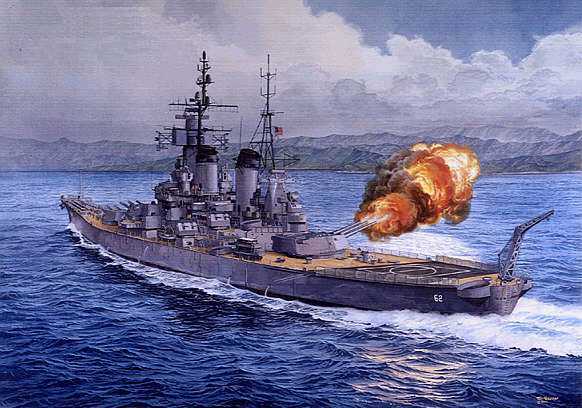
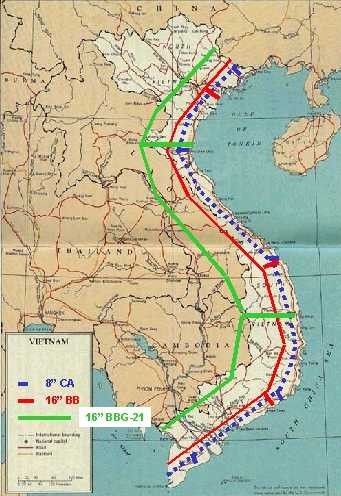
Here are the range lines for 8" Heavy Cruiser, 16" Battleship and Enhanced 16" Battleship guns overlayed Vietnam.
Some disturbing conclusions are apparent.
1. We could have and should have "gunboat diplomacied" North Vietnam using Cruisers/Battleships (AKA gunboats) and not so much fighter-bomber bombing. We know most of the POWs were shot-down pilots that could have been avoided by using naval guns instead. 114 POWs died in captivity. 1, 052 Navy/Mc aircraft were lost at a cost of $1, 052, 000, 000 or $1.52 BILLION dollars IF each one costed around $1M each in 1960s dollars.
www.mrfa.org/vnstats.htm
Casualties:
Hostile deaths: 47,359
Non-hostile deaths: 10,797
Total: 58,156 (including men formerly classified as MIA and Mayaguez casualties).
Highest state death rate: West Virginia--84.1. (The national average death rate for males in 1970 was 58.9 per 100,000).
WIA: 303,704 - 153,329 required hospitalization, 50,375 who did not.
Severely disabled: 75,000, 23,214 were classified 100% disabled. 5,283 lost limbs, 1,081 sustained multiple amputations. Amputation or crippling wounds to the lower extremities were 300% higher than in WWII and 70% higher than in Korea. Multiple amputations occurred at the rate of 18.4% compared to 5.7% in WWII.
MIA: 2,338
POW: 766, of whom 114 died in captivity.
2. If we had deployed every cruiser and battleship we had we could have used them to dial in on the easternmost parts of the Ho Chi Minh trail and possibly interdicted these routes IF we had some kind of Morice Line type fencing and ground outposts to direct the fire to land within a matter of minutes instead of the aircraft interdiction problems.
3. We could have used naval guns to suppress enemy 130mm long-range artillery that out-ranged our guns in the firebase FOB wars. We might have even been able to dominate the narrow strip of land where the two countries joined and clear the DMZ to turn it into a Morice type line that would have worked. The short range artillery firebase FOB to send out helicopters with foot sloggers CONOPS drew heavy casualties on our part and failed to be sustainable by the technology and resource poor South Vietnamese.
4. We can see that had we emphasized naval gunfire and not ignored it in favor of Midway Myth supercarrier BS, we could have had 100 mile range 16" guns that WOULD HAVE REACHED HANOI AND BEYOND. Its entirely possible that instead of Linebacker II B-52 air raids and aircrew losses we could have bombarded North Vietnam to a truce without risking ANY pilots and not going broke with expensive aircraft and munitions.
We are still screwed up. Americans still don't get it. Naval gunboats are the way to do gunboat diplomacy. We have no gunboats today. Missiles are too expensive and don't offer the demoralizing, we-can-bombard-them-forever aspect that naval guns provide. Nobody is scared of our cruise missiles quite frankly and war is a struggle to get the other side to quit.
At the operational and tactical levels, the less troops we have on the ground, the less troops we have to protect, feed and house. The less likely the civilians there will rebel against us. Having precision and MASSIVE, terrifying HE firepower at a second's call empowers our maneuver forces to defeat enemy forces in battle as well as hold key terrain like borders and sectarian partitions (hint, hint). I admit naval guns on deep hull ships would not help us deep inland in an Iraq, but they are needed if we are to secure the edges of an Iran and the Persian Gulf oil tanker routes. Mark Ash's shallow draft Monitors with guns and Ranger Larry's rocket ships could sail up the Iraqi rivers perhaps to do fire support. Certainly WIG planes. We know from the Korean war, point targets like bridges can be smashed by naval guns yet the USN bureaucracy put a clamp on this real quick lest their carriers lose the ego limelight.
In closed terrain, PLANET EARTH EATS HE FOR LUNCH. We will go broke blowing up nothing using airplanes to bomb jungle. Naval guns can inexpensively penetrate through the vegetation and hit real enemies IF we invest in some kind of agile air and ground observers to direct these fires. Naval gunfire is a national strategic, operational and tactical capability of the first order. Since the Navy/Mc do not want to do it, we should create a separate service that will do the job.
If we have to land troops, Iowas have the heavy gunfire to clear beach landing sites of potential foes. This is extremely vital since today's Landing Craft Air Cushion (LCAC) hovercraft are unarmored and cannot take even minimal enemy small arms fire, much less RPGs and anti-tank missiles. Helicopters are also extremely vulnerable like LCACs and need landing zone suppression gunfire from the Iowa's 16 inch and 5 inch guns in order to land safely and offload their troops.
Because the Iowas are armored, they can venture in close to bring their 5 inch guns to bear, adding weight to their beach landing site suppression; naval gunfire helped save the Army D-Day Omaha beach landings.
Maximizing 16 Inch guns: Scramjet Projectiles, a Revolutionary Weapon System

Details:
Scramjet projectiles, using technology now being developed for Navy and Air Force missiles, would enormously increase Navy firepower and reach -- by several orders of magnitude. The great penetration capability of these extremely high velocity rounds would be especially effective in attacking caves and deep installations. The very high velocity also means they could eventually provide highly responsive tactical fire support out to 200 miles, that could support future very deep Army Airborne and marine expeditionary force lodgments. Unlike the scramjet missiles being developed for ship Vertical Launch System (VLS) launching from soft surface ships, the armored BBG-21's projectiles can be replenished at sea; moreover, the former's number of missiles deployed is limited by the number of available VLS cells. (The DDX will have 60 to 80 cells.) The BBG-21 could carry up to 1300 scramjet projectiles, if need be, as well as 96 VLS cells devoted to land attack missiles, but generally in normal practice would probably carry about 500 16-inch scramjet to leave carry over room for other 16-inch projectiles or the JSF VSM. In addition, the scramjet projectiles, using a much simpler system, can most probably be fielded sooner (in 5 to 8 years) and at lower cost than can the more complex missiles with their separate engines. (They would certainly be far cheaper than Tomahawk cruise missiles.) Development of scramjet projectiles could, however, substantially advance Navy development of scramjet missiles that could be used throughout the fleet in all ships with VLS cells. (Note: Our 500 mile plus range and near Mach 6 speeds are, we believe, reasonable estimates of ultimate performance. The most conservative performance estimates were in a January 3, 2003 letter from Pratt & Whitney's Manger for Hypersonic Programs to USNFSA Executive Director Dr. William L. Stearman which stated: "Pratt & Whitney's initial analysis of a scramjet-powered 16-inch gun-launched projectile (Hyper Shell) indicates that a range of approximately 400nm [460 miles], a time to target of 9 minutes [Mach 5.3], and an impact velocity of 2800 feet per second is feasible." (Emphasis added)
Together, compact projectile storage and sea-based replenishment impart an unprecedented firepower to the battleship, and thus to the Navy as a whole, that has revolutionary strategic implications.
A single BBG-21 would be capable of launching up to 1300 such long-range precision guided projectiles in one day. Reportedly, the air campaign launched against Iraq on March 21, 2003 "unleashed more than 2,500 missiles and bombs across Iraq in the first 72 hours." (Washington Post 4/27/03. Emphasis added.) Two BBG-21s could, in 48 hours, have fired 2,600 precision-guided scramjet projectiles that could have precisely reached any target in Iraq within seven minutes and with a variety of warheads, including deep penetrators. (plus 96 x Tomahawk missiles). Making sure these are targets to be hit and providing honest feedback, the F-35 JSFs could on the ground and in the air provide instant feedback to miscues and enemy evasive maneuvers for future strikes to be more accurate. This does not mean BBG-21s could or should replace existing systems used in Iraq, but does demonstrate a great potential for a quantum increase in the Fleet's firepower that provides many options for executing complicated conflicts against determined and more capable nation-state foes who will not readily give us positional advantage to launch strikes with impunity (unlike Iraq).
With its at-sea replenishment capabilities and with full replenishment every third day (time depends on "hostile zone" location and available replenishment assets), one BBG-21 could hypothetically fire 433 such projectiles a day in a continuous firing attack for one week To equal this in rounds delivered would require 25 DDGs (with 96 VLS cells each) or a large part of the 37 ship DDG fleet - assuming a 5-day turnaround for the required in-port VLS missile replenishment. This would require 3,031 Tomahawks, probably more than is now in the Navy's entire inventory. VLS-launched (far more expensive) Tomahawk missiles would have a significantly longer range and heavier payloads than scramjet projectiles, but would be much slower, much easier to defend against and would have less deep penetration capability. They frankly, may simply not work against heavily concrete and steel fortified facilities. Also they, unlike the BBG-21's projectiles, could not provide oft critically needed tactical fire support and fires against moving targets. This also applies to so-called "tactical" Tomahawks, incidentally rejected by the marines [see p.17 below].) In any case, this number of DDGs would never be available for a single area land attack mission. For such missions the BBG-21s would free up most DDGs for other missions against softer targets from safer stand-off positions (e.g., ballistic missile defense and other strategic strikes).
A 500 mile or more scramjet projectile range capability would place within reach of the BBG-21's guns all of Syria and on to Baghdad from the Mediterranean; most of Iraq (including Baghdad) and most of Iran (including Teheran) from the Persian Gulf; the southern third of Afghanistan (including Kandahar) from the Arabian Sea; most of China's major cities and all of Korea. (The 500-mile range could well eventually be extended.) A pair of BBG-21s so equipped would serve as a powerful deterrent to any nation or collusion of nations with designs on taking advantage of our otherwise overly extended conventional warfare capabilities. Also just adding two BBG-21s to the fleet could, when scramjet projectiles come on line, enormously improve the Navy's ability to simultaneously cope with two major regional nation-state conflicts.
America needs the hard armored BBG-21 air/sea capability now; the endless research programs without even a viable platform must stop. We must start with a viable platform and then add the advanced precision strike technology after its been made ready in an all-out "Manhattan Project" type effort.
Project BBG-21
1. Run the BBG-21 vs. WMD war game simulations
2. Start scramjet 16" round research & development maximum effort joining forces with the South Africans who already have 155mm (6 inch) scramjet rounds available
3. Get an Iowa class battleship reactivated with a dedicated cadre active duty crew. Focus on R&D and cadre training. Reserves are not the initial answer. There is not enough time, too much personnel turbulence, not enough to start with, and you are headed for another "turret 2 explosion" due to poor training and poorer supervision. Reserves will supplement the crew once there is a well trained cadre in place that is rewarded appropriately...not stolen away after deployments by the Aegis program as happened in the 1980's
4. Arm the Iowas with 16-inch scramjet, 40/100 mile sabot rounds, VLS and network-centric warfare capabilities to create the BBG-21.
5. Concurrently re-activate the other 3 Iowa BBGs and add small flight decks/hangers to facilitate the JSFs/LAMPS helicopters. Fuel/ammo would be contained in a heavily armored Vertical Supply Module (VSM) that could be exchanged if the mission dictates for a 96-missile Vertical Launch System (VLS) module full of Tomahawk and future type missiles.
6. Experiment with "Smart Ship" automation technologies to reduce the Iowa manning requirements from 1,512 men during the '90s service period to less than 999 men total. [9] Since each Iowa BBG-21 would have the strike capability of 32 Tomahawk cruise missiles plus 16 Harpoon anti-ship missiles with either 6 F-35 Joint Strike Fighters or 96 more missiles of mission choice; their missile firepower is that of about 2 Ticonderoga Aegis class cruisers which require about 700 men; making the manning requirements of the Iowa and Ticonderoga equal for the same missile strike capabilities. [10]
However, having these capabilities in a hard armored platform with the addition of 16 inch heavy naval guns and
F-35 Joint Strike Fighters powers can defeat rogue nation-state and sub-national terror groups even if the littoral waters are contested or in enemy control. The BBG-21 can sail into these waters and take control of them away from the enemy to send a message as well as position itself for inland strike/recon missions.
The Air Force has extended the service of 1950s vintage B-52s out to 2040, the Army has modernized M113 Gavin light tracked armored fighting vehicles with hybrid-electric drives to be "stealth" tanks, essentially using "old" platforms with new technology, now the Navy must do the same and fielding BBGs to get into the fight underway now not 10 years from now. We must face the fact that the issue here is not "old" versus "new" but "right" versus "wrong". We made a mistake going away from armored platforms in favor of electronic stand-off and evasion when the truth is we need BOTH physical hard armored mobility and maximum mental warfare means.
PART 3: The Quickening
Congress has mandated that the USS Iowa and USS Wisconsin be kept in storage in a state of readiness to be brought back into service within 3 months. To prepare the way for their transformation into BBG-21 precision-strike platforms, we must bring them back to once-a-year Naval duty using the active-duty cadre. If the U.S. Navy is to remain relevant to the nation's war against sub-national terrorists and rogue nation-states it must offer precision, verifiable, deep-strike capabilities not now possible by the current aircraft bombing from soft ships and land bases from ever increasing stand-offs. These naval strikes must be instant, simultaneous and unexpected to catch the enemy's WMD weaponry and facilities off-guard which a land maneuver is always hard-pressed to get from the outset. Rapid 2D/3D land maneuver can force hidden targets into the open for precision strikes and finish the job with certainty that should always be the preferred way of operations. However, we must be realistic in that some of our enemies have good land armies and land maneuvers even well-executed raids could be seen as all-out war while a strike could be absorbed by the enemy and though disgruntled may return to a quasi-peace. Only the large 16" inch guns and heavily armored construction of the Iowa class battleships can facilitate a gunboat diplomacy that can venture into enemy waters in order to reach and precision strike deep, hardened enemy targets. The farther we try to put distance between ourselves and our targets we rely more and more on sensors that can be manipulated to spoof us to be expending ordnance on decoys or worse yet, civilians. We must use technology in the other direction---to enable us to get closer and know with greater certainty and strike harder and with greater reach. We need to be both harder and smarter. Most of the U.S. Navy geared towards launching aircraft or soft guided missiles has sat on the sidelines in the war against hidden WMDs and sub-national terrorist groups. The Navy needs muscle--mechanical advantage in the real world to hit the enemy hard not just more mental gadgetry.
To say something good about the Navy, its to be praised for over the years keeping its four modern, Iowa class battleships while other navies have embraced the soft ship and suffered the fatal consequences. Let's have our Navy show its forward-thinking again by making our battleships into the BBG-21s we need for 21st Century U.S. Naval dominance.
PART 4: The Prologue of the Future
In 2004, the tide turned and Congress and the Navy started Phase I of the BBG-21 Project. By year's end one ship was in the yards being modified, and Iowa was being towed to her workup. Both ships would be on the east coast to take advantage of centralized parts sources, support capabilities and to leverage off the synergy of two ships (they have to be TOGETHER to be successful - that is why Wisconsin was so much more effective than Missouri....she benefited from the Iowa crew's experience and the support base on the east coast). By 2005, the first ship was nearing completion of VSM/VLS and network-centric warfare suite upgrade. The rear flight ski jumps were added and Navy F-35 pilots were practicing take-offs and landings. Gun crews in the meantime had been shooting 16-inch guns at Dahlgren and Yuma proving grounds and assisting with final testing of the EX-148 13-inch 1,300 lbs sabot for fielding when the ship was re-commissioned. A selected and secret group of highly qualified fire control and gunners mates joined hand picked officers to work on the "scramjet project" somewhere in the "Blue Pacific" where two 16-inch rifles and proof carriages were quietly moved for testing support., This was a miracle of everyone pitching-in and getting the job done..
As the Wisconsin reserve crew members were doing their annual training duty on the ship, they set sail for Pearl Harbor via the Panama Canal - something our super carriers could never do. Commanded by Captain Richard Young, the crew had a few old hands from the last period of active duty who came off retirement to join the ship's crew, though it took lots of convincing of Navy personnel branch to allow them to sea. While underway only a few miles from Pearl and taking on fuel, an urgent message flashed into the CIC.
"Captain, better look at this!"
Young's blood drained from his face.
"Break away! Stop the refueling! Battle stations. Prepare for flank speed. Get everyone up. This is NOT a drill. Report back to me when this is done."
10 minutes later the refueling tanker was a spot on the horizon as the Captain spoke to everyone on the intercom.
"Gentlemen, this is your Captain. War has broken out in Korea. All we know is that enemy artillery shells are landing everywhere. The Army is getting clobbered pretty bad. I'm sorry we do not have more time to get ready. We are needed NOW. The President has ordered all of us to active duty. We have to go straight into action right now as fast as we can go and silence those North Korean guns or there ain't going to be a 'perimeter' to save. We are going to be at top speed from now on until we get there. We will make a short call at a small Pacific island and pick up our load of super-secret "scamjet shells" - something that will put the word "battle" in Battleship! We will have our three Arleigh Burke Destroyers, and one Los Angels Sub...and that is all. We will not get our cruiser for airspace management. However, we do have those crazy Joint Strike Fighters on board to keep the enemy away from the ship. The North Koreans have mined the waters all around and our carriers can't get close enough to launch planes. I'm not going to sugar coat this. This is like Guadalcanal if you know your history. There's a bunch of Army Paratroops, the 2nd ID and marines holding on against this enemy onslaught. They need us badly. I need each one of you alert and manning every gun as soon as we cross the line of death, 100 miles out from the coast of North Korea. There is going to be small suicide boats, missile boats, submarines...this is not going to be pretty. But if we can get in there and silence their guns we could turn the tide. Look at the bright side, you will not have to get all those shots you get for mobilization..."
The men were roused by the black humor. It reminded them that their skipper was confident and he would get them back home. They were reassured as much as one could be when facing imminent death. Captain Young turned the mike back on;
God speed, and God save the United States of America!".
With that Young turned the intercom off and he heard an amazing sound. "U-S-A!" .... "U-S-A!" .... "U-S-A!" it grew louder...then louder....He had never heard or felt such power. He had long thought the new generation lacked the passion of his father's generation....then he heard a cheer and the ship came to life....tears ran down his face. The state of Wisconsin song came on over the intercom, "On Wisconsin...."
As the Wisconsin reached the line of death they could see flames and smoke rising south of the land mass ahead. "Right full rudder!" The mighty ship darted straight for North Korea, no turning back now. Her only air cover was the 6 Joint Strike Fighters which were launching and the Aegis system of the Burkes. They had one Los Angeles class nuclear sub to protect from the North Korean's diesel sub threat...
"Full speed ahead!"
The radio came to life. "Boy we are sure glad to see you." It was a JSTARS aircraft from Japan flying overhead. "Sending target coordinates now".
"Closing now to gun range".
Within an hour the Wisconsin would be within range, just 225 miles out. The enemy had been caught unawares.
JSTARS also reported a warning from the nearby AWACs. "Bandits! Bearing 320. Angels 10. Range 50 miles.
Too many aircraft, I can't even count. We have to get out of here! Good luck!".
Radar operator Douglas called out; "Missiles fired!". Range 40 miles and closing.
30 miles.
20 miles.
The flight leader of the F-35s called a "tally ho!" and began attriting the North Korean fighters with AMRAAM radar guided missiles. Because they were stealthy, the North Koreans were blind-sided by missile flashes obliterating the first wave of Su-300Mki aircraft.
10 miles.
Their AMRAAMs expended, the F-35s began dogfighting with missiles and cannon, but dozens of aircraft were "leaking" through at low level---headed straight for the Wisconsin! And they were launching short-range anti-ship missiles.
"Sound collision alert!".
The Burkes fired the first missiles, hitting two incoming.
The Wisconsin's anti-missile cannon and rolling airframe missiles began firing, taking out the remaining anti-ship missiles.
"We got one....two....three".
This went on for 30 minutes....each time the missiles came in, the Wisconsin and the Burkes knocked them down. The good news was that the attack aircraft from the mainland had turned away. The JSFs were landing and being refueled, only one was damaged and landed by its ski/pop-out floats and would be retrieved later.
Then the (Close In Weapon System-CIWS) "See-Wiz", a 20mm desperation cannon began gurgling and took down another two missiles.
KABLAAAAM!!!!! A Burke was hit!
Red lights and sirens blaring. Then another missile hit, then another. Soon the Wisconsin was hit too!
The first Burke hit was stopped dead in the water. It was like the USS Cole all over again. Only this time, it was sea state four and she was floundering. All power dead...the captain gave the order to abandon ship. Wisconsin quickly put her small boats in the water to retrieve he sailors...but more missiles were incoming. The Wisconsin pressed on into gun range.
Wisconsin sustained three hits...but it was like plugging away at a palooka. No damage.
The Joint Strike Fighters were relaunched this time with sensor recon pods in search of North Korean artillery targets JSTARS had identified for Wisconsin's guns to silence.
Soon Wisconsin's fire control also had the locations of the air bases where the North Koreans were now landing on, hardened targets launching the missiles.
Captain Young calmly called in for damage reports. As they called in, the ship was ok, the missiles were too small. The aircraft had turned away. But not before radioing back that the Americans had a battleship in North Korean waters.
"We are in gun range, now, Captain!".
Young smiled.
"What are you waiting for? Open fire, we have their coordinates!". Soon the projectiles were taking out the hard targets. At the same time, the aft plotting room was receiving tactical fire missions from the troops ashore. The forward plotting room continued to receive JSF and satellite downlinks for a continuous stream of firing data on the hardened SSM sites as well as the hard nuke sites that had caused this war to flare up again. Soon the scramjet projectiles were on their way. One SSM site after another was destroyed. No amount of concrete could protect the communist gunners. There was no hiding from these hypersonic bullets.
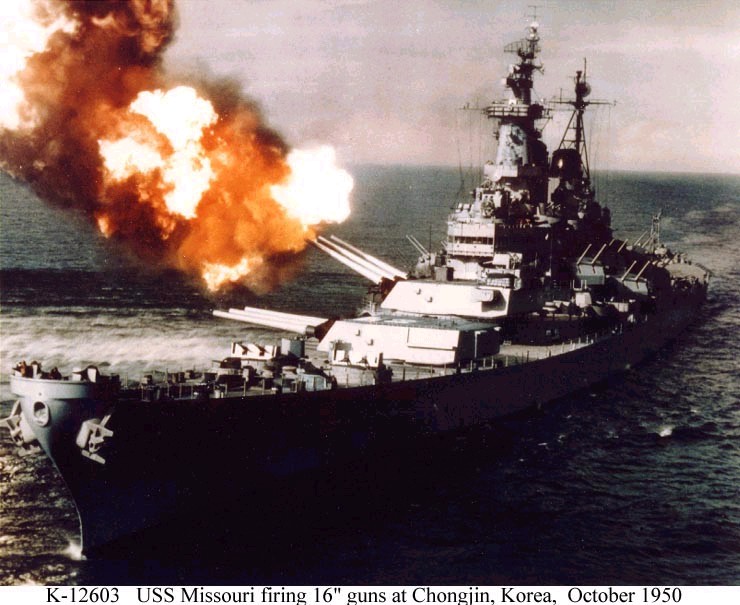
Continuing to close to within 25 miles with JSFs providing top-cover, the Wisconsin prepared to fire conventional shells.
With that order the Wisconsin's mighty 16 inch guns began to fire pummeling specific targets all along the North Korean side of the DMZ. The Paratroops holding the do-not-cross perimeter in the south suddenly heard a silence: the North Korean guns had stopped. With a stealthy F-35 Joint Strike Fighter and its sensors and air-launched UAV overhead, the Wisconsin was taking out entire North Korean artillery batteries that had arrogantly set up in the open without fear of American warplanes in the foul weather.
Within 3 hours a very significant number of the most threatening North Korean artillery pieces had been silenced and many more had been neutralized through the fear of losing their lives.
North Korean Army Headquarters, 1600 Hours
The messenger brought in the bad news.
The Communist General crumpled the paper and cursed. "The Americans have brought in a battleship and our guns won't fire anymore. We cannot move forward without suppressive fires and the weather gets better starting tomorrow morning. The enemy is smashed but we cannot make our next move south. We are now caught on the south side of the DMZ, come tomorrow morning we will be kimchi when the sun rises. Order a general retreat at once. Leave the heavy equipment and make sure no one is visible when the sun rises tomorrow. Our gamble has failed".
His aide asked him about the American battleship.
"I don't care how you do it, use one of our nuclear weapons, just sink that piece of yankee junk".
USS Wisconsin 1700 Hours
Young was running out of 16 inch ammunition, all he had left was smaller 5 inch gun ammo. His XO walked in from the bridge.
"Sir, the Army and marines are landing tonight here, north of the DMZ by sea, helicopter and parachutes. They want us to clear this beach area before they land. If they can encircle the North Koreans they could fold. They need to know if we can do it or they will call off the landings."
Young, remembering the WWII destroyers on D-Day closing to within 4,000 yards to fire point blank with 5 inch guns to save the day at Omaha beach decided with his far better protected ship to do it.
"We have more Armor than those Soldiers and marines will have".
At midnight, the Wisconsin closed to a perilous 4,000 yards from North Korean beaches and opened fire with everything she had. In the distance parachutes could be seen landing. Then Navy landing craft air cushions began to hit the beach and tiny figures came pouring out. Radio calls came in to take out specific targets. As the night wore on, the beachhead grew stronger and the North Koreans were now trapped south of the DMZ by an American blocking force. Several JSFs inserted an Army Special Forces team covertly into North Korea to report on enemy movements.
As the sun rose, the Wisconsin was let loose to return to Japan for more ammunition. This was when the North Korean suicide planes came from very low over the water, undetected by the JSF air cover.
"Bandits! Bandits! Our 6 o'clock dead astern! No missiles! No missiles!"
Young knew exactly what they were, a frustrated enemy seeking payback, by suicide. Explosions rocked the ship. CIWS knocked down a plane, then another. The JSFs swooped in and shot down several aircraft but not before some had struck the ship. These were old generation MIG-17 jets and soon all the 20mm ammo and anti-aircraft missiles were expended. But the North Korean suicide jets kept coming. Explosions ripped the ship's fragile electronic masts and sensors. At full speed heading out to sea, the attackers finally were beaten off. The ship was hit 3 times by the aircraft and severely damaged in the mid-section and stern but no damage to the hull. 25 Sailors caught in the open air had paid with their lives.
As the Wisconsin sailed into Yokosuka harbor, the media could not believe the all black ship was still afloat. Nothing could have survived such an onslaught. Except a battleship.
South Korea was saved.
BBG-21 POWER POINT SHOW
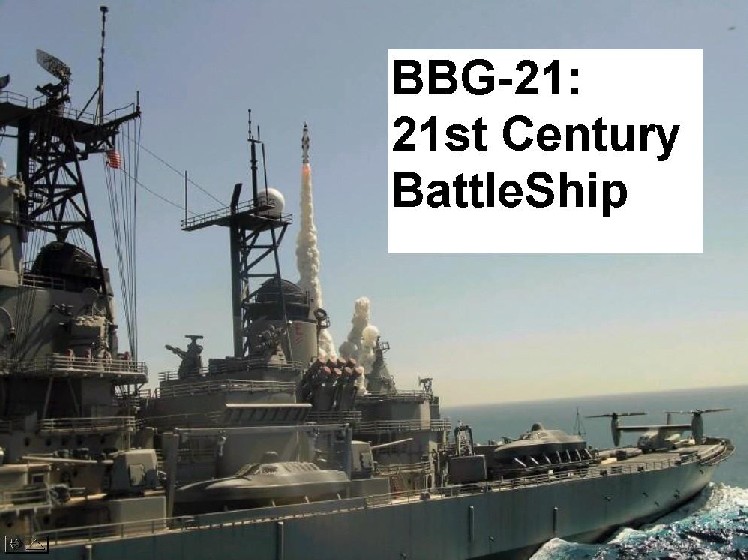
Here is a more modest BBG-21 upgrade proposed by the USNFS:
Notice the 5" guns have been modernized to 155mm (6 inch) mounts for long-range and faster rates of fire, Mark V Special Operations boats are organic to insert/extract U.S. Navy SEALs and the flight deck has a CV-22 Osprey that might be able to deploy up to 24 foot-slogging SOF commandos though a CH-53E Super Stallion or CH-47 Chinook would be better since it can carry a M113 Mini-Gavin to give the Army/Navy/USAF SOF commandos ARMORED 60 mph MOBILITY ashore with superior firepower and amounts of supplies to operate covertly for weeks. AmphiGavins can also deploy from heavy lift helicopters into the water to reach shore.
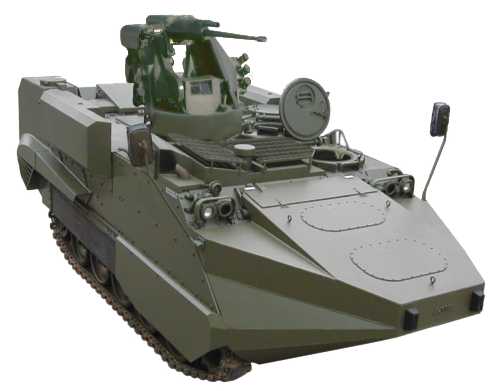
www.youtube.com/watch?v=1hbUusptJbs
Basing SOF commandos on-board heavily armored Iowa class battleships makes a lot of sense to not only intimidate foes but to stay in the area in the presence of enemy weapons to effect non-combatant evacuations of U.S. citizens, VIP rescues/snatches, direct action attacks and downed pilot rescues. Using our Aircraft Battleship configuration, SOF commandos deploying in heavy lift helicopters with AmphiGavin/Mini-Gavins would have F-35 Lightning II JSFs to provide air cover. Other SOF insert/extract options would include Little Birds in large numbers to be "Killer Bees" in effect.
Special Operations: Iowa Class Battleships heavy armor protection, firepower + AmphiGavins/Heavy Lift Helicopters = Decisive 3D Maneuver

America's four Iowa class battleships, the USS Iowa, USS New Jersey, USS Missouri and USS Wisconsin should be immediately recalled to duty on a reserve status, two BBs on each coast. Iowas can transit the Panama Canal unlike our bloated supercarriers. Our BBs are the only heavily armored surface ships we have that can survive in the face of enemy surveillance strike complex (SSC) fires. If we don't want to be driven from the surface of the sea, we need to return to a "gunboat" diplomacy that has "gunboats" not floating airfields with potential victims and hostages.
Our BBs should be upgraded into "BBG-21" configuration with two long flight decks and ski jumps to operate F-35B STOVL aircraft to provide their own air cover as well as insert/extract SOF commandos using GRIER pods.
To deliver better combat power than just foot sloggers, heavy lift helicopters like the CH-53E/K Super Stallion and CH-47F Chinook can deliver both Mini-Gavins which are reduced in size to roll-on/off from the former's rear ramps and AmphiGavins full-size using external sling loading or if they are Mini-AmphiGavins from inside.
MINI-GAVINS
The Mini-Gavin is a superior American version of the German Wiesel concept of a helicopter air-transportable tracked AFV in that its lake/river amphibious and uses proven M113 components.
The Iowa class rear deck area is very spacious as-is to operate even large heavy lift helicopters. It will be even larger with BBG-21 mods.
AMPHIGAVINS
The regular sized or mini- sized M113 Gavin can be made into the ARIS SPA waterjet and nose equipped "AmphiGavin" that can swim from ship-to-shore in oceans. In the following pictures we show AmphiGavins loading into heavy lift helicopters which can drop them off into the water to swim the rest of the way to shore or take them inland themselves. Keeping the enemy guessing and unable to react by having many deployment options is the epitome of "maneuver warfare". A stern ramp could be developed so AmphiGavins could drive into the water from the Iowa class BBG-21 to swim to shore.

Here's an imaginative 1938 Popular Science magazine cover proposing tanks-by-battleships; amazing how even today we have yet to live up to all the good ideas created in the past...
SPEEDCRANE
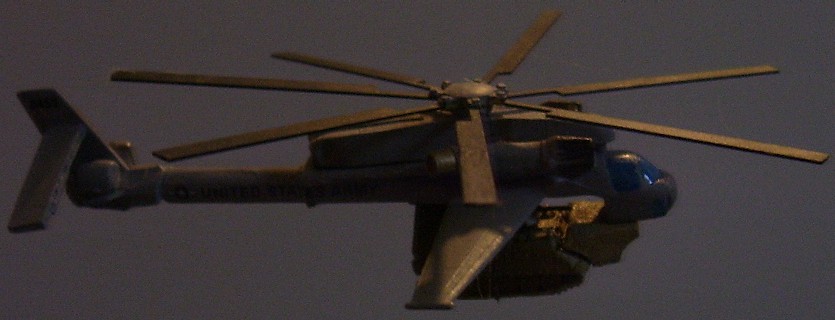
The sad truth is that conventional helicopters do not fly fast enough to survive on the increasingly missile dominated non-linear battlefield (NLB). Its high time that particularly U.S. Army Aviation wake up and stop making c'est la guerre excuses for their constant failures to improve their V/STOL flight capabilities has resulted in preventable shoot-downs and death over Iraq/Afghanistan. A great place to start would be with buying a batch of 50 x Erickson AirCrane helicopters and modifying them to be "SpeedCranes" to fly at 250+ mph with 20 ton loads. Another vital improvement would be to develop "SpeedChinook" kits for our CH-47 helicopters so they can not only air-mech Mini-Gavins faster but can deliver troops to pre-positioned shipping sets at sea to expedite their off-loading.
The possibilities an ocean-swim capable M113A3 AmphiGavin provide are exciting and only limited by your imagination to achieve surprise over the enemy. The EFV needs to be cancelled.
www.vtol.org/news/issues1004.html
Marine Corps Outlines CH-53 Heavy Lift ReplacementWith an Operational Requirements Document awaiting the signature of the Commander of Fleet Forces Command, the U.S. marine corps is moving toward a Milestone B launch decision on the CH-53 Heavy Lift Replacement (HLR) program in early 2005. The program is now aimed at 154 new-build CH-53 helicopters with first flight in Fiscal 2011, full-rate production decision in Fiscal 2013, and Initial Operational Capability in Fiscal 2015.
Separate from the Army-led Joint Heavy Lift concept studies, the marine HLR has a threshold requirement to carry 27,000 lb over 110 nm unrefueled with a 3,000 ft, 91.5 F density altitude; the objective load is 30,000 lb over the same distance. The payload is equivalent to two heavy High Mobility Multi-Purpose Wheeled Vehicles or the latest configurations of the Light Amphibious Vehicle. The totally new HLR will increase current CH-53 gross weight from 74,000 lb to 82,000 lb. At the same time, it provides an opportunity to roll back the high operating and support costs of the CH-53E with new technology.
The CH-53 HLR is now envisioned with a totally new fuselage 12 in. wider than that of the CH-53E to accommodate C-130-size cargo pallets without repacking. Longer, higher sponsons will eliminate the jettisonable tanks usually carried by CH-53Es and give the new helicopter the same fuel capacity with no increase in shipboard footprint. Fly-by-wire flight controls promise to reduce empty weight and enhance survivability. An integrated "glass" cockpit is meant to reduce crew workload and provide joint-service digital interconnectivity.
The conceptual CH-53 HLR will have three new 6,000 shp-class turboshafts driving a new split-torque gearbox. Constrained by the dimensions of existing LHA and LHD amphibious assault ships, the CH- 53 HLR will have the same main and tail rotor diameters of the CH- 53E, but it will exploit broader-chord rotor blades with advanced airfoils to hike performance. The current concept has a 79 ft diameter main rotor with 6% greater blade chord and a 20 ft diameter tail rotor with 5% greater chord. A new rotorhead with dry elastomeric bearings is expected to cut maintenance costs and last the life of the aircraft.
The marines have considered mid-life upgrades for the CH-53E since 1992 and with the extraordinary operational tempo in Iraq, Afghanistan, and elsewhere face both high operating and support costs and the impending retirement of Super Stallion airframes. A comprehensive Analysis of Alternatives completed in 2003 considered the cost and schedule history of U.S. Department of Defense aircraft remanufacturing programs. It concluded a new-build HLR program provides least risk. The marine Corps recently found the cost of remanufacturing UH-1Ns to UH-1Ys comes within 1% of the cost of a totally new helicopter and removes needed aircraft from the fleet for two to three years.
*********************
NOTES
1. North Korea Announces Year 2004 as "Year of Camouflage"
http://english.chosun.com/w21data/html/news/200407/200407220043.html
It was recently learned that North Korea designated this year as the "Year of Camouflage" and is strengthening the camouflaged tactics of its army, navy and air force in order to avoid South Korean and the U.S. intelligence nets.
According to in intelligence source, North Korea is constructing a large number of fake naval, air and army bases strengthening concealment facilities for existing bases.
The North Korean army constructed many concrete towers disguised as anti-tank emplacements near the Military Demarcation Line and created about 80 fake underground bases. On the other hand, its navy has recently been having conversations in code while maneuvering.
The reason for North Korea's camouflage is that it is known that camouflage instructions worked well in Iraq War. In addition, the nation seeks to free itself from the threat posed from newly introduced weapons such as unmanned "Predator" aircraft and bunker-busting BU-37 bombs.
www.dia.mil/Site5/Aboutdia/milthreats/sscibrief.html
The U.S. Defense Intelligence Agency (DIA) defines "Cover, Concealment, Camouflage, Denial and Deception (C3D2). Many potential adversaries, nations, groups, and individuals are undertaking more and increasingly sophisticated C3D2 activities against the United States. These operations are generally designed to hide key activities, facilities, and capabilities (e.g. mobilization or attack preparations, WMD programs, advanced weapons systems developments, treaty non-compliance, etc.) from U.S. intelligence, to manipulate U.S. perceptions and assessments of those programs, and to protect key capabilities from U.S. precision strike platforms. Foreign knowledge of U.S. intelligence and military operations capabilities is essential to effective C3D2. Advances in satellite warning capabilities, the growing availability of camouflage, concealment, deception, and obscurant materials, advanced technology for and experience with building underground facilities, and the growing use of fiber optics and encryption, will increase the C3D2 challenge.
The term for hardening your missile launching systems is "second strike" capability. India is developing this.
www.rediff.com/news/1998/may/21bomb4.htm
2. South African 155mm scramjets
www.somchem.co.za/rockets.html
3. If America's military does not refocus from air and maritime firepower onto decisive land maneuver she will not win the war against global Islamofascist terrorism and is at risk at nation-state war defeat by rival techo-economic peer competitors
During the Battle for Leyte Gulf in WWII, Admiral "Bull" Halsey was led away by a Japanese decoy fleet leaving the invasion force exposed to Japanese battleship attack. Admiral Nimitz grew confused about the situation off Samar, he requested that Halsey be given a gentle nudge, to ask what the location was of Admiral Lee and his fast battleships. The message sent by Admrial Nimitz and received aboard the New Jersey was "TURKEY TROTS TO WATER GG WHERE IS RPT (repeat) WHERE IS TASK FORCE THIRTY FOUR RR THE WORLD WONDERS". When the message was delivered to Halsey, the padding "Turkey trots to water" had fortunately been removed, but the signalman recording the message failed to remove "the world wonders" from the end of the message. Halsey read the message as a stinging slap from his friend and advocate, and with great emotion threw his cap to the deck. And then, reluctantly, he ordered his battleships to proceed South in an attempt to respond to Nimitz and to save Kinkaid. Unfortunately, due to his northern position, he would arrive off Leyte a day after the Japanese had left. Had Halsey stayed on station off San Bernardino Straight, he would have had his massive surface battle. Had he continued on to the north, a different yet still massive surface battle would have resulted. But, instead, his fleet of fast battleships sailed ineffectually between the two engagements, unable to participate in either.
www.battleship.org/html/Articles/History/Leyte6.htm
4. Are the U.S. Navy and marines off on a "from the sea..." tangent like Halsey was at Leyte Gulf, as the real war on terrorism rages elsewhere on land?
The point of maritime power is to control and influence human beings who live on land though the medium of the sea, and the skies/space above. The sinking of enemy capital ships is a means to this end not an end unto itself. The American Navy/marine corps have not realized that human wars are finally fought & won on land, but have contented themselves to stopping short with their naval means. The Navy will sink ships and bombard targets with air and missile strikes. The marines want to seize beachheads and do evacuations using primarily rubber-tired trucks and foot infantry, rapidly returning back to their ships to eat ice cream and trash talk the other services that they were somehow the "first to fight" (and leave) while the U.S. Army already there hours and days before by USAF parachute airdrop/airland has to do the dirty inland warfighting thereafter. While the war against Islamofascist sub-national terrorists rages on land, $BILLIONS of dollars are spent on blue water ships to sink other enemy ships in Senators Trent Lott and John Warner's home states that provide little or any help in this fight for American physical and cultural survival against a Islamofascist backlash.
How did we go so far astray?
The shocking revelations that are coming out from internet information sharing is that we have totally misunderstood WWII naval history.
The cliche' is that the war at sea was won by large deck aircraft carriers which made gun battleships obsolete which U.S. establishment historians have foisted upon us. Commentator Dave B. writes:
www.warships1.com/US/BB61stats/index-BB2-pst04.htm
Aerial dominance over battleships: a reality check.
Sunday, 13-Dec-98 13:02:11
First a disclaimer; this in know way is intended to discredit aircrews at all. It takes balls the size of which you use to bowl to strap yourself in a cockpit and go to war. I have much admiration and respect for aircrews and the incredible job they have done. This is simply to point out that maybe the idea that battleships are relegated to "aircraft targets" is a bit premature. Now to the point.
Keep in mind that when I refer to "modern" battleships, I am referring to those which were designed and built after WWI.
We have all heard and read that the airplane relegated the battleship to a secondary role proving it was the dominant threat. While this may essentially be true, I believe it is overstated in reference to how vulnerable battleships were to WWII aircraft. Let me explain.
A reality check is needed to demonstrate the actual results of aircraft versus battleship in WWII. The first step is to realize that only THREE modern battleships succumbed to combined aerial ordnance: Prince of Wales, Mushashi, and Yamato. In the case of the Japanese battleships, coordinated torpedo attack was almost impossible until bombs neutralized the massed AA firepower. In any event, Mushashi required 20 torpedoes & 33 bombs, while Yamato required 10 torpedoes & 23 bombs to sink using an overwhelming force of aircraft. We have read the excellent post on this board which pointed out that air interdiction of Kurita's force was an abstract failure: they failed to halt the Japanese surface fleet and only succeeded in sinking one battleship. Also keep in mind the Japanese air protection was non-existent when they lost these two battleships. In the case of Prince of Wales, she was hampered by inadequate AA, lack of escorts and air cover. In addition a torpedo impacted the stern bending a propeller shaft while she was underway hastening her demise. (Others here are far more qualified to analyze damage that a bent propeller shaft can cause. This situation also happened to Pennsylvania, but, fortunately, she was at anchor at the time minimizing the damage in contrast to POW)
I have to wonder why only THREE modern battleships succumbed like this if the aircraft were, supposedly, SO MUCH MORE POWERFUL. Look again at the Japanese battleships and you can see than ONE CV sinking ONE BB is not very probable at all. Many of our battleships were hit, but few seriously damaged and none sunk after Pearl Harbor.
As a way of contrast let's look at list of some battleships destroyed while they were stationary targets (moored, laid up, etc.):
Royal Oak - U-Boat torpedoes.
Strasburg - aircraft bombs.
Oklahoma - aircraft, 5 torpedoes.
Arizona - aircraft, 1 torpedo & 8 bombs.
Marat - aircraft, 1+ bombs.
Tirpitz - aircraft bombs.
Schleswig Holstein - aircraft bombs.
Gneisenau - aircraft bombs.
Schliesen - aircraft bombs.
Lutzow - aircraft bombs.
Scheer - aircraft bombs.
Conti di Cavour - aircraft torpedoes.
Haruna - aircraft bombs.
Hyuga - aircraft bombs.
Ise - aircraft bombs.
15 battleships, 5 modern and 10 old. (Okay, I know I'm considering the Deutschlands as battleships instead of extremely heavy cruisers) I don't think I forgot any, but add to the list if I did. Again, not to take away from aircrews, but destroying stationary warships is a far cry from doing the same thing when they are at sea and readied for war. Keep in mind that some of these vessels were attacked repeatedly, even though sitting stationary & unable to much about the attacks against them.
How about battleships destroyed in surface actions?
Hood, Bretagne, Bismarck, Scharnhorst, Hiei, Kirishima, Fuso, and Yamashiro. Now it's 2 modern and 6 old.
In addition, we have the following victims (Mutsu, Kongo, & Roma all have additional factors involved. Roma was destroyed by glider bomb, but she was not prepared for action and little better off than our BB's at Pearl Harbor)
Barham (underway)- U-Boat, 3 torpedoes.
Graf Spee - scuttled after surface action.
Mutsu - accidental explosion.
Kongo (underway) - slowed down & blew up two hours after Sealion torpedoed her.
Roma (underway, barely) - German glider bomb.
If I missed any or if I made any mistakes on this list feel free to correct me.
The question: is destroying stationary battleships a testament to their vulnerability to aircraft?
I think not.
If air power was so much more dominant, then why were 8 battleships sunk in surface actions yet only 3 during air actions? (Roma was technically an air action, so we could say 4 instead of 3) Also remember how many battleships were damaged by air attack but failed to sink. The only American battleship that even came close to this was Pennsylvania. North Carolina, South Dakota, Pennsylvania, West Virginia, Maryland, Nevada, New Mexico, Mississippi, California, & Colorado, to name as many as I can off the top of my head, all received major damage in WWII after Pearl Harbor. They all survived the war. The aircraft proved for certain their power over battleships sitting stationary, but I think the ability of aircraft to destroy battleships which are underway AND ready for war is quite overstated.
Even Pearl Harbor needs to be looked at. Oklahoma was hit by 5 torpedoes. Even this was not the critical factor in her turning turtle, but the fact that there was no time to set condition Z, nor was damage control even close to attempt counter flooding, and the fact that she was hit so many times so QUICKLY spelled her doom. Her outer strakes simply flooded too fast and without counter flooding, she rolled over. Arizona, it is thought, was destroyed because the converted 16" shell used as a bomb set off the highly unstable black powder magazine (used for the catapult) which in turn set off the main magazine. A fluke. Others had the time to counter flood so as to prevent Oklahoma's fate. West Virginia was struck by SEVEN torpedoes, and counter flooding saved her. My point is this; even Pearl Harbor does not prove that battleships are totally vulnerable to air power.
I posted this a result of a "Heated" discussion I just had. Take the bible: remove anything out of context and you can prove anything you damn well want to. As a comparison, simply shooting off with statements about how events in WWII prove how battleships are helpless against aircraft is simply untrue. You must get the big picture and see the WHOLE thing. Carrier aircraft are valuable and can strike deep into enemy territory, and are very versatile. But battleships too can deliver destructive blows and are still needed today. Besides, WWII proved just how rugged battleships are, and in the big picture of actual events, aircraft were not nearly as dominant over battleships as so many have professed.
Aircraft victims (including Roma): Stationary = 14 battleships, underway = 4 battleships.
Surface action: 8 battleships.
Other (including Royal Oak): 5 battleships.
God bless ALL our vets!
Dave B.
The truth is that both the Japanese and American Navies still believed in armored gun battleships and these vessels were sunk far less often than unarmored aircraft carriers were during all of WWII. Furthermore, to sink other enemy ships there are other, better ways to include seaplane patrol bombers and submarines than large deck aircraft carriers. American subs and PBY seaplanes did far greater damage to Japan than the large deck aircraft carriers. These truths have long been suppressed by a U.S. Navy bureaucracy bent on creating the large aircraft carrier myth. Another one is that the U.S. Navy created the aircraft carrier.
Details:www.combatreform.org/p6mseamaster.htm
The one thing that quickly became apparent to the Japanese after Midway was that pilots to FLY aircraft cannot be mass-produced. When aircraft carriers launch all their aircraft they are defenseless and easily sunk. This happened repeatedly during WWII with aircraft carriers even sunk by gunships if they ventured too close. This is the rub, the primary benefit of the aircraft at sea is STAND-OFF, the ocean is still a very large place and if you can see the enemy's ships hundreds of miles away first and strike them first they will not get within gun range. The problem is that once the carrier loses its planes its unarmored easy meet for battleships and today missile ships on top of the previously mentioned submarines and patrol bombers. Aircraft carriers are one dimensional threats. The U.S. Navy works around aircraft carrier weakness by surrounding them with missile and anti-submarine ships to protect them when they are threatened by these asymmetric weapons. However this entire "house of cards" soon collapses once the carrier's deck is wrecked and planes and pilots start splashing into the water. America today is not fully mobilized ala WWII to mass-produce pilots. If we lose pilots there will be none to replace them for the war at hand. In a major nation-state shooting war, we will only have the pilots we had when the war began, and when we lose them we could have carriers with decks empty of both planes and pilots like the Japanese found themselves at the end of WWII. It will not be 5 years of war that brings about this condition, it will be 5 weeks or 5 days of modern war.
5. Surface ships are endangered species in a world covered by surveillance means and multiple guided HE weapons
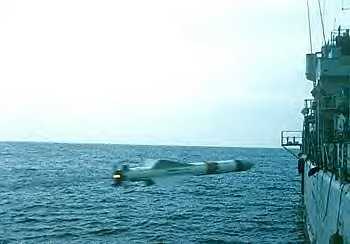
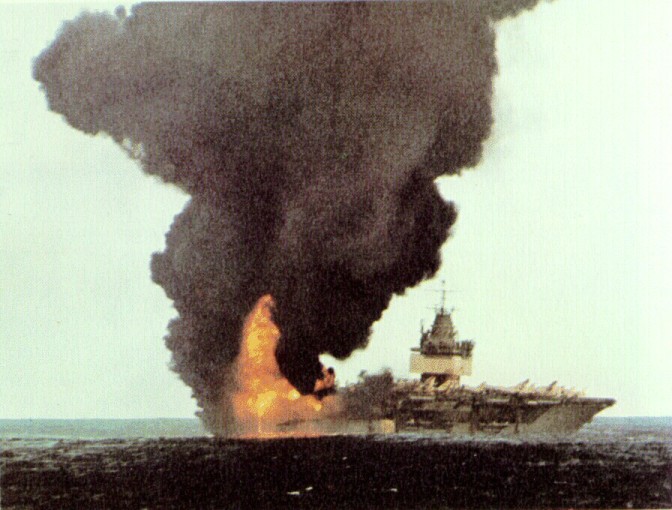
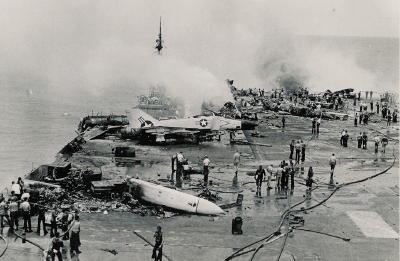
WWII's true lessons learned is that surface ships must be heavily armored to survive against aircraft with high explosive bombs, torpedoes and missiles. The debacle off Okinawa in 1945 when human Kamikazes dove planes into our unarmored aircraft carriers is an ominous warning of what guided missiles/bombs are like today, but this danger sign has been ignored for 6 decades because the U.S. Navy has been given a free pass at sea with no one attacking it.
The 1982 Falklands War almost ended badly for the British had not the Argentine bomb fitters failed to properly fuse bombs for A-4 SkyHawks and Mirage III jets. Our days of being lucky at sea are about to end.
Our globally connected world has many satellites in space flying overhead that can spot surface ships creating what the Russians call a "Surveillance Strike Complex" (SSC). The side that then has the most platforms to then take this info and hunt down the other's surface ships has the edge. However, the U.S. Navy is physically emasculating itself into LESS PLATFORMS and less coverage of the seas and skies. Less is less, not more. Furthermore, a littoral strategy of trying to remain relevant in today's 4th Generation Wars (4GW) which are fought by dissatisfied sub-national groups has large blue-water ships coming to the enemy which simplifies his task of locating our fleet even easier. With the possible land-based cost effectiveness "edge" if a nation-state backs the sub-national foes, they could rain down upon the American fleet thousands of lethal, guided missiles that are sure to damage and kill. Because the U.S. Navy is based on faulty assumptions from WWII that everything must center around the large deck aircraft carrier which causes physical cost emasculation by less platforms we are setting ourselves up for a modern-day Gallipoli type amphibious failure on the watery edges of land and HMS Repulse/Prince of Wales large loss of life at sea.
6. Aircraft Battleships
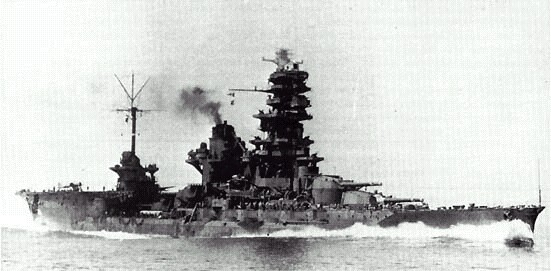
www.steelnavy.com/HasegawaBBHyugaNT.htm
As a direct result of the Japanese fiasco at Midway, on April 28, 1943 Hyuga went into another major refit, which lasted from May to November 1943. Ise had preceded her in this refit from February to August 1943. This time they were rebuilt into curious battleship/carrier hybrids. With the removal of the last two turrets, the aft 40% of the ship was greatly built-up by incorporating a hangar 60 meters long and flight gear for 22 13-Shi D4Y4 Suisei "Judy" wheeled dive bombers. The bombers could not fly from or land on the flight deck, which was primarily used for handling, preflight operations and storage. Two new catapults were added just aft and on either side of the forth turret. Using the turntables and rails on the nonfunctional flight deck, the bombers would be loaded onto the catapults to be launched and would have to be recovered at a land strip or fully functional carrier.
In any event, the Judys were not available so Hyuga received 14-Shi Aichi E16A1 "Paul" floatplanes instead of the planned Judys. In addition Ise appears to have received some Aichi D3A1 "Val" bombers, while running trials in August 1943. All of the original 5.5-inch secondary guns were landed and the 5-inch AA gun fit increased to sixteen. Light AA also jumped up to 57 25mm guns. Because the weight of the removed turrets was greater than the additional fittings, to balance the ship, the flight deck received an 8-inch layer of concrete. Lastly, in a belated effort to keep pace with the ever-increasing edge that the USN enjoyed in technology, Ise was fitted with Type 21 radar and Hyuga with Type 22 radar. Throughout 1944 the pair received greater numbers of light AA guns. In June 1944 the total was 108 25mm guns, organized in 31 triple mounts and 15 single mounts. September saw a new addition. Six mounts, each of which contained 28 4.7-inch rocket tubes were added to the aft end of the flight deck with three mounts on sponsons on each side. Since by that time the twins had no operational aircraft, extra AA was mounted on the flight deck and the two catapults were landed to improve the arc of fire of turret numbers three and four.
http://smmlonline.com/articles/ise/ise.html
IJN Ise/Hyuga BBCV
By: Daniel H. Jones
-----------------------------------------------------------------------
Prior to World War II several navies operated aircraft carriers or aircraft support ships. The three major powers, England, the USA, and Japan developed what came to be known as fleet carriers and gave much thought as to their most effective employment. From a glance at the ship listings it might seem that the aircraft carrier was the dominant force but this was not so. The "gun club" element still dominated strategic thought in all three navies. Carriers were regarded as supporting ships to the battle line, providing scouting planes to locate the enemy and to launch strikes to "soften up" the opposing fleet so they could be finished off by the battleships. Nowhere was the cult of the battleship as "queen of battle" more strongly entrenched than in the Imperial Japanese Navy. Their strategic plan for fighting the U.S. Navy was to lure the American fleet across the Pacific for a great climactic battle in home waters. The total destruction of this invading force was to be accomplished by... the battleships, much as the Russian fleet was annihilated at the Battle of Tsushima. That the battleship was still predominant in IJN planning is supported by their commitment to the construction of the most powerful examples of the type ever built, the Yamato class. With the formation of the Kido Butai, (the Nagumo task force), the Japanese invented the carrier task force concept that proved so effective later in the war. Obviously there were many officers with advanced ideas regarding carrier aviation but they were still in the minority. In the IJN the "gun club" still controlled planning and policy decisions.
Ironically, the Japanese Navy was to prove the fallacy of this thinking with their preemptive strike on the USN battle line at Pearl Harbor. With no battleships available the USN was forced to shift their emphasis to the aircraft carrier as the center of a striking force, though they still continued to build a new generation of battleships. At the Battle of the Coral Sea neither fleet sighted the other, the entire battle being decided by carrier aircraft. At Midway, when four Japanese carriers were lost orders were issued to continue the operation. The battle fleet was to close and destroy the American ships. After a few hours of steaming towards Midway the orders were rescinded and the surface fleet withdrew. The lesson was obvious and could not be ignored. A surface fleet could not survive without carriers when facing a fleet that had them. The battleships were impotent in the face of this new threat.
In the days following the debacle at Midway, the Japanese Navy frantically sought ways to make good their carrier losses. Some submarine tenders and seaplane tenders were available for conversion to carriers, (they had been designed with this in mind). Suitable liner hulls were taken over for conversion to light carriers. Most radical, especially in the eyes of traditional line officers, was the plan to take four battleships out of the battle line and modify them to operate aircraft. The Fuso, Yamashiro, Isa, and Hyuga were selected for this conversion which consisted of removing the aft two turrets and constructing a handling deck, hangers and two catapults. The decks would not be large enough for take off or for landing aboard so the aircraft would have to be catapult launched and be equipped with floats to land alongside and be hoisted aboard. A new type of fast seaplane, capable of both scouting and attack, was to be designed for these ships. Conversion began on the Ise and Hyuga but the planned work on Fuso and Yamashiro was held back pending testing results from the first two ships. Work on the seaplane, the "Norm", went forward but very few were built. Neither Ise or Hyuga ever operated aircraft apart from some limited testing. There were never enough aircraft to equip the ships and there was also a shortage of trained pilots. In their only sortie in this configuration, the Battle of Leyte Gulf, both ships were part of the Ozawa decoy force and had no aircraft on board. Almost all of the carriers in this group were sunk but both Ise and Hyuga sustained only minor damage.
After returning to home waters, both ships had their catapults removed. This was done to improve the arcs of fire for the center turrets. The IJN was now totally on the defensive and the concept of operating seaplanes on Ise and Hyuga was abandoned. Both ships remained anchored in home waters for the remainder of the war. Both were sunk at Kure Harbor in shallow water by air strikes from U.S. navy carrier planes.
In 1/700 scale Hasegawa has kits of this class in both versions, as a battleship, (Hyuga), about 1941 and as the unique BB/CV, (Ise), after conversion. This article will primarily concentrate on the Ise, the BB/CV version. This is one of the earlier efforts in the waterline series and has a number of omissions and inacuracies, mainly due to the need for many parts to be common to both kits. Too many compromises have been made for the sake of ease of production but most can be dealt with. Bridge levels and platforms are essentially correct for the Ise and apart from cleaning up and adding better parts and photo etch there is little to be concerned with here. (If you are doing the earlier battleship version some major rework is needed on the bridge). One omission should be added, the supporting legs of the underlying tripod structures that the platforms are built on. From the back and side of the bridge these legs are external and very visible. Locate the positions on each level and drill boles on each platform. When assembled, except for the top two levels, insert two lengths of plastic rod through the platforms down to main deck level. This will make a tremendous improvement in the appearance of the bridge structure.
The main problem with the Ise is in the area of the catapults. Hasegawa has the catapults standing alone from the aft structure and this is wrong. A structure connects the catapults to the aft area and this will have to be added. It looks formidable but it is really quite easy to do. See the sketch drawings and the templates for guidance. Note also the forward legs of the aft tripod structure are exposed also. These can be added from plastic rod as was done for the aft side of the bridge.
Masts, particularly the large mainmast, should be replaced with scratch built assemblies from plastic sprue or brass wire. Most of the splinter shields could be improved by replacing with Evergreen plastic strip. Gold Medal Models makes a photo etch sheet, IJN Battleships, that contains the lattice supporting structure around the funnel as well as two catapults. Adding this will improve the model very noticeably.
The supports under the aircraft deck edges are solid triangles of plastic on the kit. These are individual strut supports on the ship and can be improved upon by either replacing or by carving away the back side of the plastic. I prefer the latter method, see sketches. Also, at the stern, the supporting lattice structure is solid and has been simplified. This should be cut away and a scratch built replacement fabricated. This is the hardest job and there is really no short cut that I have discovered. You may opt to forget about doing this as the overhang hides much of the area when looking at the model from above.
All of the guns can be improved by replacement from the Skywave weapons sets, particularly the 25mm which should come from set E-7. Some of the Skywave ship's boats are nicer also. For railings, I recommend the Tom's Model Works, two bar set.
Aircraft: If you resolve to display aircraft on board or on the catapults, there is no "Norm" available but testing was done with the Nakajima "Pete" and with the Kawanishi "Jake". Both types are available from the Skywave sets or from other kits in the waterline series. I would recommend replacing the Hasegawa "Jakes" with other parts as they are a little crude in appearance compared to some of the other planes available.
As you can see, some considerable investments in both time and money for extra materials are necessary to bring this kit up to speed. Whether it is worthwhile depends on how well you like the subject. Ise is one of my favorite ships, having built four models of her over the years in four different scales. If you do all of the suggested modifications and additions the results are very noticeable and the kit can look right at home with other ships in your collection. An old kit is not especially a bad kit, it just needs more work.
7. The Hybrid Warship by R.D. Layman and Stephen McLaughlin.
www.amazon.com/gp/reader/1557503745/ref=sib_rdr_ex/104-4143826-4615900?%5Fencoding=UTF8&p=S004#reader-link
Layman concludes contrary to those who misquote him further their anti-aircraft on battleships agenda, that new technologies like V/STOL make it possible. He cites the Russian Kiev class missile cruiser/aircraft carrier's success as final proof.
www.hazegray.org/navhist/carriers/russia.htm#kiev-cl Kuznetsov class multi-role aircraft carriers
Displacement: 67,000 tons full load
Dimensions: 984 x 124.5 x 36 feet/300 x 38 x 11 meters
Extreme Dimensions: 990 x 239 x 36 feet/301.8 x 72.8 x 11 meters
Propulsion: Steam turbines, 8 boilers, 4 shafts, 200,000 hp, 30 knots
Crew: 1500 plus air wing
Armor: uncertain; probably little or none
Armament: 16 SS-N-19 Shipwreck SSM, 18 8-cell SA-N-9 Gauntlet SAM VLS, 8 CADS-1 CIWS (each 2 x 30mm gatling AA plus 16 SA-N-11 SAM), 6 AK-630 30 mm gatling AA, 2 RBU-12000 ASW rocket launchers
Aircraft: approx. 30
Concept/Program: The first true Soviet carriers, intended for overseas deployments, intervention, etc. in the manner of US carriers. An adventurous design, but not fully successful. The second ship was left incomplete following the breakup of the USSR.
Design: Generally based on the Kiev hull but with significant enlargement and improvements. Full flight deck, angled landing deck, but a ski-jump is fitted instead of catapults, due to failures in the catapult development program. Extremely heavy missile armament, including heavy SSMs in VLS set into the flight deck. Intended to operate navalized versions of regular Soviet fighter and attack aircraft, plus naval helicopters. Aviation features are reported to be poorly designed. The ship uses the Kiev machinery and has suffered machinery problems.
Operational: Did not become operational until 1995. Has made only one deployment, and the possibility of future deployments is uncertain. Air wing was made up of Su-27 variants and variants of the standard Soviet/Russian shipboard helicopters.
Aichi E16A Short Take-Off, Water Landing (STOWL) floatplane
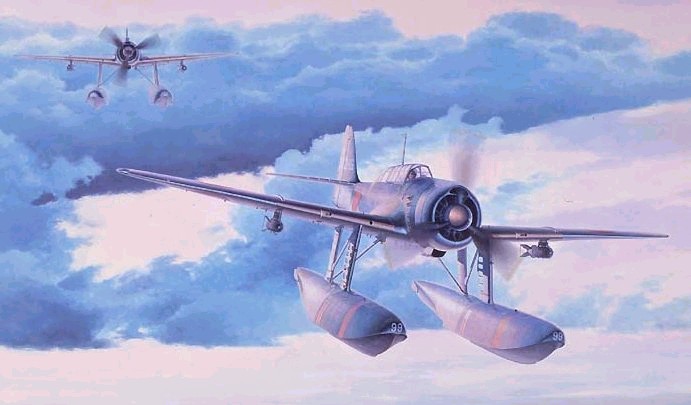
www.7sea-traders.co.za/index4.html
E 16 A "Paul" Cat. No. SH 72013
The Aichi E16A floatplane was designed as an AM-22 project in order to meet the Navy 14-shi requirements for a two seat reconnaissance floatplane, possessing dive bombing capabilities. Changes in the specification during design, resulted in re-designation to a 16-shi type. The first prototype was finished in May 1942, however a lot of improvements had to be completed before series production started. With perforated dive brakes mounted on the front legs of the N-struts, strengthened floats, and improved actuation system of Fowler-type flaps, the E16A1 was accepted for production in August 1943. 252 series aircraft were built. This airplane designated as a Navy Reconnaissance Seaplane "Zuiun" Model 11, was armed with two 20 mm cannons in the wings, and one flexible 13 mm machine gun. It could also carry one 250 kg bomb under the fuselage. The "Zuiun" (known as a "Paul" by the Allies) entered service during the defense of the Philippines in 1944, and due to the enemy air superiority suffered heavy losses. Most surviving "Zuiuns" were used for suicide attacks and training. Specifications: Wingspan: 12,81 m, Length 10 833 m, height 4.791 m, engine MK8A Kinsei 51 or MK8D Kinsei 58 (1300 hp), maximum weight 4553 kg, max. range 2420 km, max. speed 440 km/h.
8. Iowa Class Aircraft Armored Battleships with organic fighter-bombers
The stage is set today for F-35 STOVL fighters to operate from the stern deck area of Iowa class armored battleships like the SC-1 SeaHawk STOWLs of old.
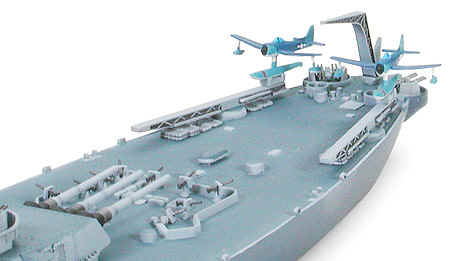
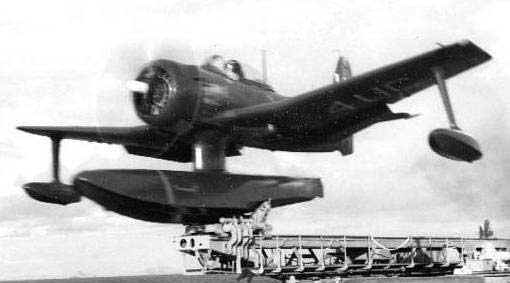
The Iowas are the only ships in the Navy today that could survive a SSC missile bombardment. We need an Iowa class fast BBG on each coast for each ocean manned by reserve crews to speed to the scene of a conflict and then stay there on station and not be run off by enemy missile attacks. While on station, I estimate 6 x F-35 JSF STOVLs could be parked and operate from two angled take-off planks with ski jumps on the port and starboard sides of the Iowa class BBG. The F-35s would enable the Iowas to see and attack enemy aircraft and fighters (without them necessarily seeing the stealthy JSF on radar) to self-protect the ship. Small scale inland strikes could be done using F-35 JSFs in advance of the sunday punch arrival. "Gunboat diplomacy" in time of peace when sub-national groups appear would mean F-35 strikes against these targets as soon as they pop up not waiting for days for a carrier battlegroup to reach the scene.
Once the landing ground maneuver forces arrive, the Iowa class battleships can rain lethal and saturating fires upon landing beaches to clear them for our troops to land safely using their 9 x 16" naval guns. Without these powerful and long reaching fires to at least suppress dug-in enemies, our troops landing could be repelled by withering guided missile and RPG fires that make the D-Day opening scenes of the movie "Saving Private Ryan" look like child's play. An anti-tank guided missile (ATGM) can with nearly 100% certainty hit any landing craft we send to the beach, destroying it and everyone inside. The Germans did not have this on Normandy in 1944 but our enemies of 2004 have them today. We are going to need every ounce of fire support possible to even have a chance of prevailing on today's non-linear SSC battlefields. Avoidance of the enemy via costly and absurd Over-The-Horizon (OTH) means which only delay the problem of what happens when you land is a deluded pipe dream. A smart enemy will be dispersed, camouflaged and will wait to mass and deliver his knock out blows upon the landing forces after we are already committed to our destinations. Landing vulnerable, temperamental-to-control V-22 tilt-rotors without suppressive guns onboard and offloading troops on foot without AFVs is sheer lunacy. Trying to waterski AAAVs from 50 miles out and then retracting skis in a huge target with a smother-the-dozen-infantry-in-back-turret on top is more stay-in-your-WW2-Iwo-Jima-frontal-assault-lane madness.
For SSC fires to be effective against enemies who know to hide using Camouflage, Cover, Concealment, Deception and Deceit (C3D2), the ugly truth is that we need spotters ideally on the ground and in the air. The Iowa's F-35 STOVLs would be two-seat versions with an observer in back facing aft to help spot enemy targets below and in the air during dogfights. Underwing JPODs that could carry two men inside could also be carried to insert/extract 4-man special forces teams to spot for air strikes and the Iowa's 16 inch naval guns. These teams could also laser target designate for aircraft bombs and guided 16 inch shells to land with precision. JPODs and skis with pop-out floats would enable the F-35 to land and rescue servicemen in the water.
www.geocities.com/usarmyaviationdigest/jsfspecops.htm
Even with good terminal guidance, air strikes are expensive and not often effective against deep dug-in targets like belligerent nation-states that are developing weapons of mass destruction hidden from the rest of the world. If we are to strike at these deeply buried targets we need more MUSCLE not just hair-splitting mental guidance. The current trend towards guiding smaller and smaller ordnance has failed and DoD is wanting to develop small earth-penetrating nuclear bombs. The emasculation of DoD through misguided visions of precision guidance as a firepower panacea has brought us on the verge of ruin inland where our neglected maneuver forces are losing control. Reversing this trend by opening the "nuclear genie" is a desperate and unwise action. If we nuke (WMD) even a remote area of the world where we think the enemy is developing WMDs, we will be in no position to condemn what they are doing because we just launched a WMD of our own. In 4GW, legitimacy of effort in the eye's of the world is vital to success. And if the enemy's WMD facilities are in the middle of civil populations are we going to Hiroshima millions of people to pre-empt a similar WMD attack on our own people? Earth penetrating nuclear bombs dropped by aircraft that can get shot down is fraught with more negatives than positive outcomes.
What we need is to take the largest gun cannon we have and fully develop its physical powers to strike deep enemy C4I and WMD targets with morally justifiable high chemical---not nuclear explosives. That weapon is the 16 inch guns on the Iowa class battleships. We can extend its nearly 25 mile ranges to 500 miles with scramjet technology that then dive at hypersonic speeds to penetrate deep into the earth to destroy enemy hardened facilities. And facilities like this are BIG---we need more than a handful of $1 million missiles, we need hundred and thousands of scramjet shells to take these targets out with areas saturation and not risk men overhead trying to drop bombs looking for bull's eyes when there are none.

The Japanese aircraft battleships, Hyauga and Isa were never supplied their floatplane STOWL fighter-bombers to give the concept its "day in court". Gerald Bull never got to fully develop large caliber guns as a means to reach space cheaply or to strike military targets from super long ranges. The full potential of our Iowa class battleships has yet to be fulfilled. We should modify and bring back the first two Iowas in mothballs and get the USS Missouri and New Jersey back from talk about the good 'ole days museum duty (sorry, national security comes first) as soon as possible.
The U.S. Navy and marines are drying up into physical emasculation and irrelevancy as costs increase for fewer and fewer ill-conceived techno-cashcows that render pork for Senators Lott and Warner's home states. America needs more not less naval combat platforms to do relevant MANEUVER things in today's 4GW world. Our warning could be the near-debacle at Leyte Gulf in 1944. The clever Japanese baited Admiral Halsey's powerful fleet of large aircraft carriers and battleships north after their empty aircraft carriers. Meanwhile, the 7th Fleet which was landing General MacArthur's U.S. Army troops to take back the Philippines were left for the two Japanese battleship task forces to blast them to smithereens. Fortunately, wiser heads had realized it's the AIRCRAFT that are what's important not the aircraft carrier, and had created dozens of escort carriers using merchant ship hulls. In order to get more platforms ie; more aircraft into the fight since we had both pilots and planes, they went with a no-frills approach. The CVEs were to employ fighter-bomber aircraft to primarily render Close Air Support (CAS) by bombing and strafing for the ground maneuver troops ashore. When the Japanese battleships' pagoda like masts were spotted on the horizon, a desperate and courageous fight ensued with destroyers laying smokescreens and firing torpedoes as the CVEs turned into the wind and launched every plane they had to stop the Japanese. Without armor-piercing bombs it was nearly hopeless to sink the battleships but the courageous pilots strafed and fragmentation bombed the Japanese battleships which included the Isa and Hyuga aircraft battleships---without floatplane fighter-bombers into thinking that they had bumped into Halsey's fleet. The Japanese turned away just when they were getting into gun range and wipe out our invasion fleet. Details:
www.battleship.org/html/Articles/History/Leyte0.htm
The message here is clear with 20-20 hindsight. Had the Japanese Isa and Hyuga battleships had the 28 x Aichi E16A Paul floatplane fighter-bombers they were supposed to have they could have seen that they had hit pay dirt and caught the American invasion fleet. Furthermore, they could have shot down some of the CVE's aircraft and bombed the CVEs into flaming ruins such that their returning aircraft would have had to ditch into the sea. On the positive side, the fact that we did not put all our aircraft "eggs" in expensive and few fleet aircraft carriers, we had enough AIRCRAFT to turn away the Japanese who did not have aircraft. The key was to have aircraft in multiple platforms any way you could get them. Many in DoD are fond of saying we need "effects based operations" (EBOs). The ultimate "effect" is having enough and superior qualities of platforms and capabilities to prevail over our enemies, a truth we have forgotten and need to relearn before its too late.
Where is Task Force 34?
Where is the U.S. Navy and marines as the U.S. Army is stuck fighting the global war on terrorism on land?
Do they want to help or continue to chase their feel good dream foes?
9. Iowa Class Battleships 1,512 men
www.warships1.com/US/USbb61-Iowa.htm.
Iowa Class Battleships
Last Edited 23/10/03
The largest and most powerful battleships ever built for the United States Navy, these ships were a marked departure from previous designs in that speed was a defining factor in their design, making them the fastest battleships ever built by any nation.
Enhancing on the very satisfactory armor scheme from the South Dakota class and being armed with more powerful 50 caliber instead of 45 caliber 16" rifles as on the South Dakota's and North Carolina's, plus their enhanced speed, a full 6 knots faster then previous USN designs, made these ships the most powerful and among the fastest surface assets in the Navy.
Their huge number of anti-aircraft weapons gave these ships a new life during World War II in their job of protecting the aircraft carriers.
Post-war, their large, accurate and powerful main batteries were used to very telling effect as shore bombardment tools in every major conflict the United States was involved in post-WWII and with newly installed land and ship attack missiles they formed the most powerful surface task groups the world has ever seen in the 1980s.
Even today in the 21st century over 50 years after they were commissioned, there has been no replacements built that can equal much less surpass their effectiveness and deadliness as shore bombardment ships.
Two of these grand ladies have been relegated to museum status, but two are still listed on the Naval Vessel registry as assets.
Visit The U.S. Naval Fire Support Association
A Site Dedicated To Bringing The Battleships Back To Frontline Service
Show Your Support!! Let's Get The Big Boys Back In Action!!
Pictures
Current Status
Commanding Officers
BB61 Iowa "Big Stick"
Builder New York Navy Yard- New York,NY
Keel Laid Jun.27/40
Launched Aug.27/42
Commissioned Feb.22/43
DECOM#1 Mar.24/49
RECOM#1 Aug.25/51
DECOM#2 Oct./52
RECOM#2 Apr.28/84
1980's Modernization
modernized at Avondale Shipyards (drydocking Sep./82)
preliminary work began Oct./82
completed at Litton/Ingalls
DECOM#3 Oct.26/90
Stricken Jan.12/95
Status History
U.S.S. Iowa BB-61 Association
BB62 New Jersey "Big J"
Builder Philadelphia Naval Shipyard- Philadelphia, PA
Keel Laid Sep.16/40
Launched Dec.7/42
Commissioned May.23/43
DECOM#1 Jun.30/48
RECOM#1 Nov.21/50
DECOM#2 Aug.21/57
RECOM#2 Apr.6/68
DECOM#3 Dec.17/69
RECOM#3 Oct.28/82
1980's Modernization
modernized at Long Beach Naval Shipyard
DECOM#4 Feb.8/91
Stricken Jan.12/95
Status History
U.S.S. New Jersey BB-62 Association
BB63 Missouri "Mighty Mo"
Builder New York Navy Yard- New York,NY
Keel Laid Jan.6/41
Launched Jan.29/44
Commissioned Jun.11/44
DECOM#1 Feb.26/55
RECOM#1 May.10/86
1980's Modernization
modernized at Long Beach Naval Shipyard starting May.25/85
DECOM#2 Mar.31/92
Stricken Jan.12/95
Status History
U.S.S. Missouri BB-63 Museum Association
BB64 Wisconsin "Wisky"
Builder Philadelphia Naval Shipyard- Philadelphia, PA
Keel Laid Jan.25/41
Launched Dec.7/43
Commissioned Apr.16/44
DECOM#1 Jul.1/48
RECOM#1 Mar.3/51
DECOM#2 Mar.8/58
RECOM#2 Oct.22/88
1980's Modernization
modernized at Philadelphia Navy Yard (prep work)
Avondale Shipyards (drydocking Aug./96)
and completed at Litton/Ingalls
DECOM#3 Sep.3/91
Stricken Jan.12/95
Status History OFF SITE
U.S.S. Wisconsin BB-64 Association
BB65 Illinois
Builder Philadelphia Naval Shipyard- Philadelphia, PA
Keel Laid Jan.15/45
Status cancelled Aug.12/45
scrapped Starting Sep./58
BB66 Kentucky
Builder Norfolk Naval Shipyard- Portsmouth, VA
Keel Laid Mar.7/42
unfinished hull launched Jun.8/42
restarted Dec.6/44
Launched launched incomplete Jun.8/42
restarted Dec.6/44
suspended Feb.17/47
resumed Aug.17/48
Jan.20/50
Status cancelled Jan.22/50
bow removed May./56
Jun.9/58
sold Oct.31/58
towed Feb./59
scrapped starting Feb./59 at Baltimore
Dimensions
BB.61 BB.62 BB.63,64 BB.65,66
Length(O/A) 887' 2.75" 887' 6.625" 887' 3" 887' 3"
Length(W/L) 859' 5.75" 859' 10.25" 860' 860'
Beam 108' 2.063" 108' 1.375" 108' 2" 108' 2"
Draft(max) 37' 9" 38' 37' 9" 35' 10"
Draft(mean) 36' 2.25" 36' 0.25" 36' 2.25" N/A
Draft(design) 28' 8.25" 28' 8.5" N/A N/A
The Wisconsin's Length May Have Changed Slightly After Her Collision With The Destroyer-Escort Eaton On May.6/56 And Her Subsequent Fitting Of A New Bow From The Incomplete Kentucky.
Displacement
Displacement (1943-45)
BB.61 BB.62 BB.63 BB.64 BB.65-66
Maximum 59,331 tons 59,300 tons 59,331 tons 58,751 tons 55,250
Light Ship 43,875 tons 43,944 tons N/A N/A N/A
Design 45,000 tons 45,000 tons 45,000 tons 45,000 tons 45,000 tons
Displacement (1968-69) BB.62 New Jersey Only
Full Load 57,124 tons
Displacement (1982-92)
Full Load 57,256 tons
Light Ship 45,280 tons
Displacement (Hull,Armor Etc.)
Hull 22,852 tons
Hull Fittings 1,908.5 tons
Armor 10,252 tons
Machinery 4443.8 tons
Main Armament 5,100 tons
Anchors stockless bower type
30,000 pounds each
each chain is 187 fathoms (1,122 feet) long, including the outboard swivel shot
Propulsion
Boilers 8 Babcock & Wilcox 3 drum express "M" type
fitted with controllable superheat dual furnaces and double uptakes
Pressure 565 psi
Temperature 850 degrees F (454.4 degrees C)
Turbines 4 sets General Electric geared turbines (BB 61,63,66)
4 sets Westinghouse geared turbines (BB 62,64,65)
HP turbine ,combined LP/Astern turbine connected to a locked-train, double reduction gear
Horsepower 212,000 shp forward
254,000 shp overload forward
44,000 shp astern
Shafts 4
Endurance 20,150 NM @ 15 knts
15,900 NM @ 17 knts (estimated)
4,830 NM @ full power
Speed 33.0 knots @ 202 RPM
34-35 knots has been unofficially achieved in service in 1987
Generators 8 turbogeneratos (1,250 kilowatts) (1945)
2 emergency diesel (250 kilowatts) (1945)
total capacity 10,000 kilowatts,450 volts AC (1945)
Tactical Diameter 1,430 yards @ 33 knts
814 yards @ 30 knts
Oil Bunkerage 9,520 tons
approx. 2,500,000 gallons
Protection
Side Belt 12.2" on 0.875" STS plate inclined 19 degrees (38.6' wide, top 10.6' class A)
1.5" STS outer hull shell (decapping plate)
Lower Side Belt 12.2" tapered to 1.625" inclined 19 degrees
1.5" outer hull shell (decapping plate)
Deck Main 1.5"
2nd 4.75"-5" Class B + 1.25 STS"
3rd 0.5" to 0.625"
splinter 0.625" STS (BB.61-62)
splinter 0.75" STS (BB.63-66)
Bulkheads 11.2" (BB.61-62)
14.5" (BB.63-66)
Barbettes 17.3"-14.8"-11.6" to second deck
3" 2nd-3rd deck
1.5" below 3rd deck
Turrets face plates 17"+ 2.7"
sides 9.5"
back plates 12"
roof plates 7.25"
Secondary 2.5" STS
handling rooms 2.5"
Conning Tower sides 17.5"
roof 7.25"
deck 4"
communications tube 16"
Immunity Zone 17,600 yards to 31,200 yards vs 2,240 lb AP shell @ 2520 ft/sec
below 12,000' vs 1,600 lb AP bomb
Weapon Systems
Weapon Systems (1943-45)
Click here for information on USN radars
Main Battery 9 x 16"/50 cal (Mk 7) in 3 triple turrets
2 forward 1 aft
Shell Capacities
16" turrets Turret I: 387
Turret II: 456
Turret III: 367
Total: 1,210
Powder Capacities
16" turrets Mk 4 Full Service, Mk 8 Reduced Service
Turret I: 843 Mk 4 or 989 Mk 8
Turret II: 743 Mk 4 or 874 Mk 8
Turret III: 928 Mk 4 or 1,148 Mk 8
Totals: 2,514 Mk 4 or 3,011 Mk 8
Secondary 20 x 5"/38 cal (Mk 12) in ten twin turrets
5 port 5 starboard
Shell/Powder Capacities
5" mounts Magazine B-311-M 5" powder: 2,018 powder cases.
Magazine B-312-M 5" powder: 2,088 powder cases.
Magazine B-313-M 5" projectiles: 2,277 projectiles.
Magazine B-314-M 5" projectiles: 2,155 projectiles.
Magazine B-332-M 5" powder: 1,925 powder cases.
Magazine B-333-M 5" powder: 1,799 powder cases.
Magazine B-334-M 5" projectiles: 1,444 projectiles.
Magazine B-335-M 5" projectiles: 1,334 projectiles.
Magazine B-355-M 5" powder: 2,665 powder cases.
Magazine B-356-M 5" powder: 2,737 powder cases.
Magazine B-357-M 5" projectiles: 2,781 projectiles *
Magazine B-358-M 5" projectiles: 3,272 projectiles **
*During modernization removed stowage for 570 rounds of common but added in 96 rounds of White Phosphorus.
Modernization era capacity was 2,307 rounds.
** During modernization removed stowage for 760 rounds of common but added in 96 rounds of
White Phosphorus and 24 rounds of WP Drill. Modernization era capacity was 2,632 rounds.
AAW 60-80 x 40mm/56 cal Bofors (15-20 x 4)
49-60-20mm/70 cal Oerlikons in single mounts
Air Search SK-2
SC-2
Surface Search SG
SU
Fire Control Mk 27 Mk 13
Mk 12 Mk 22
Mk 35
Mk 4
Mk 8
Main Gunfire Control 2 Mk 38
2 Mk 40
Secondary Gunfire Control 4 Mk 37
40mm Weaponry Control Mk 56
All 20mm were removed post-WWII,many of the 40mm were also removed.
Weapon Systems (1969) BB-62 New Jersey Only
Click here for information on USN radars
Main Battery 9 x 16"/50 cal (Mk 7) in 3 triple turrets
2 forward 1 aft
Secondary 20 x 5"/38 cal (Mk 12) in ten twin turrets
5 port 5 starboard
Air Search SPS-6C
Surface Search AN/SPS-10B
Fire Control Mk 27 Mk 13
Mk 12 Mk 22
Main Gunfire Control 2 Mk 38
2 Mk 40
Secondary Gunfire Control 4 Mk 37
Weapon Systems (1982-92)
Click here for information on USN radars
Main Battery 9 x 16"/50 cal (Mk 7) in 3 triple turrets
2 forward 1 aft
Shell Capacities
16" turrets Turret I: 387
Turret II: 456
Turret III: 367
Total: 1,210
Powder Capacities
16" turrets Mk 4 Full Service, Mk 8 Reduced Service
Turret I: 843 Mk 4 or 989 Mk 8
Turret II: 743 Mk 4 or 874 Mk 8
Turret III: 928 Mk 4 or 1,148 Mk 8
Totals: 2,514 Mk 4 or 3,011 Mk 8
Secondary 12 x 5"/38 cal (Mk 12) in 6 twin turrets
3 port 3 starboard
Shell/Powder Capacities
5" mounts Magazine B-311-M 5" powder: 2,018 powder cases.
Magazine B-312-M 5" powder: 2,088 powder cases.
Magazine B-313-M 5" projectiles: 2,277 projectiles.
Magazine B-314-M 5" projectiles: 2,155 projectiles.
Magazine B-355-M 5" powder: 2,665 powder cases.
Magazine B-356-M 5" powder: 2,737 powder cases.
Magazine B-357-M 5" projectiles: 2,781 projectiles *
Magazine B-358-M 5" projectiles: 3,272 projectiles **
*During modernization removed stowage for 570 rounds of common but added in 96 rounds of White Phosphorus.
Modernization era capacity was 2,307 rounds.
** During modernization removed stowage for 760 rounds of common but added in 96 rounds of
White Phosporus and 24 rounds of WP Drill. Modernization era capacity was 2,632 rounds.
CIWS 4 x 20mm/76 cal Mk 15 Vulcan Phalanx 6-barrelled Gatling
2 port 2 starboard
2 x Mk 32 25mm Bushmaster chain gun were installed during "Earnest Will"
12.7mm HMG's and 40mm grenade launchers were carried during "Earnest Will"
SSM 32 x RGM-74 Tomahawks in 8 quad Mk 141 ABL launchers
4 port 4 starboard
SSM 16 x RGM-84 Harpoons in 4 quad launchers
2 port 2 starboard
Anti-Torpedo SLQ-25 Nixie towed torpedo decoy
Anti-Air Mk 36 SRBOC chaff launcher
ECM/ESM AN/SLQ-32(V) 3 ECM
Mk 12 IFF
Air Search AN/SPS-49
Surface Search AN/SPS-67
Fire Control 2 AN/SWG-1A Harpoon wcs
1 AN/SWG-2(V) Tomahawk wcs
Mk 13
Mk 25
Main Gunfire Control 2 Mk 38
Secondary Gunfire Control 2 Mk 37
All older small caliber weapons were removed from all ships in 1980s modernizations
Aircraft
1943-1945 3 Vought OS2U Kingfisher floatplanes
1945-1947 2 Curtiss SC-1 Seahawk floatplanes
1951-1953 1 Sikorsky HO3S-1 helicopter
1968-1969 (New Jersey only) SNOOPY QH-50 control and telemetry system
(Gun-Spotting surveillance version of DASH)
1983-1992 1 Kaman SH-2 Seasprite helicopter: more could be carried
1-3 Pioneer UAVs (Unmanned Piloted Vehicles)
Pioneer UAV taking off from Iowa
Pioneer UAV information page
RPV and Helicopter Fueling and Storage (1983-1992)
(contributed by Dick Landgraff)
The fuel stowed in a 500 gallon bladder in one of the aft gun tubs was Motor Gasoline (Mogas) for the RPV.
The bladder was also in a dolly type carriage that could be jettisoned quickly in case of fire.
JP-5 for the helos was stowed in new tanks below 3rd deck on the starboard side aft.
The space originally held two cylindrical tanks of Mogas that were cut up and removed.
However, the two tanks on the port side remained as day tanks for JP-5.
Helo maintenance was operated out of the old movie booth on centerline, main deck just aft of turret III.
Helo ops were controlled by a new control station built on 02 level and over the top of turret III.
Helo stowage was intended to be on the long ramp forward of the helo deck on the starboard side.
Port side was intended for a boat trailer stowing two motor whaleboats.
A new boat boom was added to the port side of the after superstructure to handle those boats.
RPV's were stored in hut-like canisters and assembled out on deck.
Plans were drawn for a semi-permanent hangar where RPV maintenance and assembly could be done out of the weather.
Complement
Design 1,760 enlisted-- 91 officers
1945 2,788 (BB 61)
2,753 (BB 62)
2,978 (BB 63)
2,911 (BB 64)
1982-92 1,512
10. CG-47 Ticonderoga-class
www.globalsecurity.org/military/systems/ship/cg-47-specs.htm
CG-47 Ticonderoga-class
Specifications
Builders Ingalls Shipbuilding: CG-47-50, CG 52-57, 59,62, 65-66, 68-69, 71-73
Bath Iron Works: CG-51,58,60-61,63-64,67,70
Propulsion 4 General Electric LM-2500 Gas Turbine Engines (80,000 Shaft Horsepower)
2 Controllable-Reversible Pitch Propellers
2 Rudders
Length Overall Length: 567 ft
Waterline Length: 529 ft
Beam Extreme Beam: 55 ft
Waterline Beam: 55 ft
Draft 33 ft Maximum Navigational Draft
24 ft Draft [keel]]
23 ft Draft Limit
Displacement Light Displacement: 7103 tons
Full Displacement: 9957 tons
Dead Weight: 2854 tons
Speed 30 plus knots
Aircraft Two SH-2 Seasprite (LAMPS) helicopters in CG 47-48
Two SH-60 SeaHawk helicopters (LAMPS III)
Armament 1 MK 7 AEGIS Weapons System
2 MK26 missile launcher (CG47-51) or
2 MK41 vertical launching system (CG52-73)
0 VLS Cells
127 VLS Cells Standard Missile (MR)
Anti-Submarine Rocket (ASROC)
Tomahawk ASM/LAM
2 x Harpoon Missile Quad-Canister Launchers
2 MK 32 MOD 14 Torpedo Tubes - 6 MK-46 torpedoes
2 MK 45 5"/54-Caliber Lightweight Gun Mounts
1 MK 15 MOD 2 Close-in-Weapons Systems (CIWS) (2 Mounts)
1 MK 36 MOD 2 Super Rapid-Blooming Off-Board Chaff System
2 x 50-Caliber Heavy Machine Guns
Combat Systems Earlier Ships
1 AN/SPY-1A Radar (Four Arrays) (CG47-59)
1 AN/SPS-49 Air Search Radar
1 AN/SPS-55 Surface Search Radar
1 AN/SPQ-9 Gun Fire Control Radar
4 AN/SPG-62 Illuminators
1 AN/SQS-53A Hull Mounted SONAR (CG47-55)
1 AN/SLQ-32(V)3 Electronic Warfare Suite Later Ships
1 AN/SPY-1B(V) Multi-Function Radar (CG59-73)
1 AN/SPS-49(V)8 Air Search Radar
1 AN/SPS-55 Surface Search Radar
1 AN/SPS-64(V)9 Navigation Radar
1 AN/SPQ-9 Gun Fire Control Radar
4 AN/SPG-62 Illuminators
1 AN/SQQ-89(V) 6 ASW Combat System
1 AN/SQS-53B Hull Mounted SONAR (CG56-67)
1 AN/SQS-53C Hull Mounted SONAR (CG68-73)
1 AN/SQR-19B Towed Array SONAR (TACTAS)
1 AN/SLQ-32A(V)3 Electronic Warfare Suite
Crew 24 Officers, 340 Enlisted
Unit Operating Cost
Annual Average $28,000,000 [source: [FY1996 VAMOSC]
11. General Battleship Links
www.geocities.com/equipmentshop/battleships.htm
www.geocities.com/Pentagon/Quarters/6747/21centbattleships.htm
www.warships1.com/BB61stats/index-BB2-pst03.htm
www.warships1.com/W-Iowas/index3_BB2_pst12.htm
www.warships1.com/W-Iowas/index3_BB2_pst14.htm note: he overstates newer Soviet anti-ship missiles toward the end. Their warheads aren't that powerful - he's probably thinking of the older AS-2/3/4 with 1000 kg (2200 lb) warheads
www.warships1.com/W-Iowas/index3_BB2_pst11.htm
www.g2mil.com/battleships.htm
www.spclevents.com/wwwboard/messages/2430.html
World Navies Today - an exceptionally good site that lists a great deal of info on the composition and ships of current navies. A great deal of information on all ships, including transport and support vessels, can be found for each navy. A great reference for building your own fleet.www.hazegray.com/worldnav

The U.S. military is on the verge of losing some of its most effective weapon systems and political-military instruments: the Iowa-class battleships the Navy is now in the process of eliminating from the fleet.
Two ships, the USS Wisconsin and the Iowa, are in limbo and the other two the USS Missouri and the New Jersey, are to be turned into museums. If the cannibalization and demilitarization of these four ships is not soon halted, these ships could shortly be rendered unsalvageable, or at least very costly to salvage.
Continuing to maintain all four in mothballs costs less than $400,000 a year, whereas eliminating them will cost taxpayers far more. For example, one disposition plan for just the Missouri could cost taxpayers up to $11 million.
Most importantly, this move will eliminate forever one of the most useful and versatile weapon systems this nation has, and virtually eliminate the Navy's ability to provide adequate naval gunfire support in a future conflict.
The Navy appears to have been furtive in getting rid of the battleships. Not only was Congress not consulted, but some of the key Navy people concerned were neither consulted nor informed.
In April 3 congressional hearings, then Navy acquisition chief Nora Slatkin and Adm. Thomas Lopez , deputy chief of naval operations for resources, warfare requirements and assessments stated they were unaware of the Navy's decision, actually taken in January, to strike the battleships. In fact, Lopez indicated the Navy was upgrading its main guns.
Sen. John Warner, R-Va., former Navy secretary, wrote to Adm. Mike Boorda, chief of naval operations, on May 4 requesting that he "delay this process and return these ships to their 'deactivated' status until we all have had an opportunity to evaluate their potential in light of future requirements for all-weather fire support."
He added, "The cost of maintaining these valuable ships in mothballs is small compared to the cost of destroying their capability. Once they are gone, we cannot recoup our loss."
The battleship cannot be matched when there is a need for a truly effective show of force in coastal regions. Most of the world's population lives within range of its 16-inch guns. The battleship's awe-inspiring and threatening appearance can be a powerful psychological deterrent in crisis areas.
I am absolutely convinced that a battleship stationed off Kuwait in July 1990, and our declared readiness to use it, could well have discouraged Iraq from attacking, sparing us the enormously costly Persian Gulf war.
By the same token, a battleship positioned close to Panama City in October 1989 could probably have intimidated President Manuel Noriega into stepping down without our direct (and expensive) intervention.
Other U.S. naval vessels, by comparison, show at most two small guns and most look more like merchant vessels than warships. The Soviets, on the other hand, deliberately designed their ships to look war-like, bristling with external ordnance. This is why they were so disturbed by recommissioning our battleships. (Editor: read Van Crevald's Technology and War, this is a vital capability]
Our two battleships in the Gulf war did a magnificent job in providing heavy fire support for our troops, firing more than 1,100 16-inch rounds during 83 naval gunfire support missions. In addition, they provided essential services for other ships, coordinated all Tomahawk operations, assisted in antisubmarine warfare operations and attacked distant targets, including some in Baghdad. In fact, the USS Wisconsin fired the first Navy shots of the war, Tomahawk missiles.
Soviet respect for the battleships was well reflected in a gulf war report in Sovetskaya Rossiya, Feb. 19, 1991. "The battleship has been conducting a methodical shelling of reinforced concrete shelters constructed by the Iraqis on Kuwait territory . . . .(The two battleships') salvos, according to representatives of the command element of the multilateral forces, are producing a 'strong impression' on the Iraqis: They are abandoning their coastal positions and pulling back northward tens of kilometers."
Battleships are the only U.S. ships that can operate relative impunity in the Persian Gulf and in other areas of potential threat. Unlike the other ships, they are so heavily armored and thoroughly protected they cannot be knocked out by the conventional weapons we are most likely to encounter, such as Silkworm and Exocet missiles, bombs and mines.
On the other hand, we had during the Gulf War the example of the USS Princeton, a $1 billion Aegis-class cruiser, which had its back broken by a mine that cost next to nothing. This cannot happen to a battleship.
A battleship's guns can, in one half hour, accurately lay down tonnage of high explosives equal to that delivered by 15 x B-2 sorties. Comparing bombardment rates, within range of its guns, the battleship can in one hour lay down 56 times the tons delivered from a carrier.
Battleships are often dismissed as dinosaurs of another age. Actually, they are among the fastest ships afloat and have been well modernized and equipped with unmanned aerial vehicles, which were very effective in the gulf war. In any case, they are far less old fashioned than the artillery that every modern army considers essential, and naval guns are every bit as essential as artillery.
The Tomahawk missiles, of which the Navy is so enamored, are far more expensive and, for the most part, not an adequate for gun the Navy has all but abandoned. Navy ships now carry only one or two 5-inch guns.
The irony here is that the Navy announced in September 1992 that it was shifting from a blue water to a "brown water", or "littoral" strategy.
Unfortunately for the battleships, it has powerful foes in the Navy. Earlier, they were mainly senior aviators. In recent years, however, the main opposition has come from those who favor only high-tech, new construction, which has produced very expensive, highly specialized thin-skinned ships vulnerable to a host of low-cost weapons, and unsuited for littoral operations.
In 1964, during the Vietnam War, it was proposed to bring back a battleship. Opponents delayed its arrival until late in 1968 after the United States had stopped attacking North Vietnam. Eighty percent of all the targets we struck by air in North Vietnam could have been taken out with 16-inch guns, sparing us most of the many hundreds of aircraft and air crews we lost.
Eventually, the New Jersey was recommissioned and sent to Lebanon. It was considered for retaliatory use after a Syrian attack on a U.S. reconnaissance plane over the Bekaa Valley, but carrier-based air power was employed and it cost one pilot killed, one captured one A-6 and one A-7 lost and another A-7 damaged.
Ten days later, when we encountered the same problem, 16-inch guns were used and with 11 rounds knocked out six Syrian anti-aircraft missile sites in the Bekaa Valley. On Feb. 8, 1984, after Syrian artillery had bombarded West Beirut with more than 5,000 rounds and silenced all the Syrian batteries.
I believe that, for purely parochial reasons, dominant factions in the Navy want to see battleships eliminated as soon as possible, so they can never again be recommissioned using assets they covet for their favorite ships and projects.
More important links:
Tactically Responsive Firepower, Military Review July/August 2001 by Major Tracy Ralphs, U.S. Army Reserve
